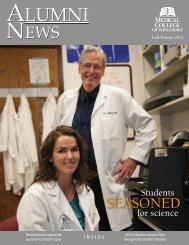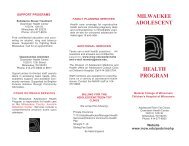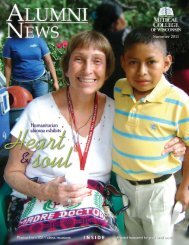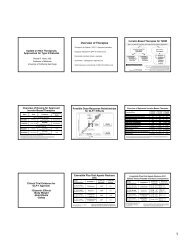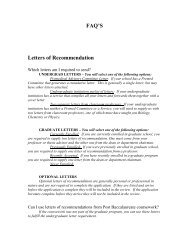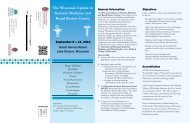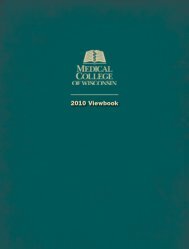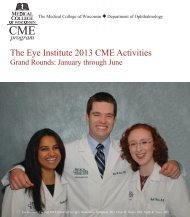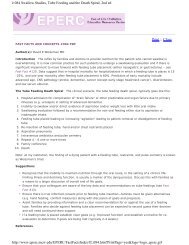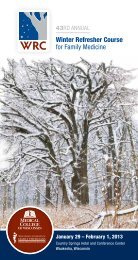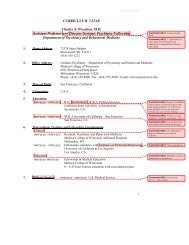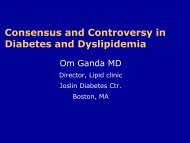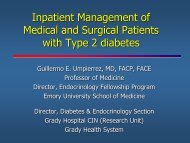Spring 2011 issue (pdf) - Medical College of Wisconsin
Spring 2011 issue (pdf) - Medical College of Wisconsin
Spring 2011 issue (pdf) - Medical College of Wisconsin
Create successful ePaper yourself
Turn your PDF publications into a flip-book with our unique Google optimized e-Paper software.
A LUMNIN EWS<strong>Spring</strong> <strong>2011</strong>Head casesSports-related concussions startingto receive appropriate attentionFunctional connectivity unlockingnew knowledge about diseasesINSIDEN S IDEGraduate School dean describesvision, educational philosophy
An alumnus and highly respectedfaculty leader <strong>of</strong> the <strong>Medical</strong><strong>College</strong> <strong>of</strong> <strong>Wisconsin</strong> has agreed toserve as the <strong>College</strong>’s Dean in aninterim capacity. On Jan. 21, the Board<strong>of</strong> Trustees approved the appointment<strong>of</strong> Joseph E. Kerschner, MD ’90, Fel’98, as Interim Dean and ExecutiveVice President. In this role, Dr. Kerschneris the <strong>Medical</strong> <strong>College</strong>’s senior<strong>of</strong>ficer overseeing medical education,research, patient care, and public andcommunity health.Dr. Kerschner was previouslySenior Associate Dean for ClinicalAffairs - Children’s Specialty Group,and CEO <strong>of</strong> Children’s SpecialtyPRESIDENT’S MESSAGEGroup, a pediatric specialty practicethat is a joint venture <strong>of</strong> the <strong>Medical</strong><strong>College</strong> and Children’s Hospital <strong>of</strong><strong>Wisconsin</strong>. Dr. Kerschner also formerlyserved as Interim Chairman andPr<strong>of</strong>essor <strong>of</strong> Otolaryngology andCommunication Sciences.*A board-certified otolaryngologist,Dr. Kerschner has served on the<strong>Medical</strong> <strong>College</strong>’s faculty since 1998.As a physician at Children’s Hospital<strong>of</strong> <strong>Wisconsin</strong>, his clinical focus is onotitis media, airway reconstruction ininfants and children, and congenitalhead and neck masses and neoplasms.His research interests include identifyingthe genetic causes and potentialnew treatments for pediatric earinfections.Dr. Kerschner is a Fellow <strong>of</strong> theAmerican Academy <strong>of</strong> Otolaryngology,the American <strong>College</strong> <strong>of</strong> Surgeons,and the American Academy <strong>of</strong>Pediatrics. He has served on severalscientific review panels for theNational Institutes <strong>of</strong> Health’s (NIH)National Institute on Deafness andOther Communication Disorders, andis a recipient <strong>of</strong> NIH research grants.He has published or presented morethan 100 articles, book chapters,reviews and abstracts in pr<strong>of</strong>essionaljournals or at scientific meetings.Dr. Kerschner succeeds JonathanI. Ravdin, MD. A national search isunderway to identify the next Deanand Executive Vice President, whomthe <strong>College</strong> hopes to have selected andin place by July 1, 2012.John R. Raymond, Sr., MDPresident and CEO* ALUMNI NEWS pr<strong>of</strong>iled Dr. Kerschner in 2009: mcw.edu/alumni/KerschnerPr<strong>of</strong>ile.ASSOCIATION MESSAGEIam filled with optimism for the<strong>Medical</strong> <strong>College</strong>’s future under newleadership. As Alumni AssociationPresident, I have personally observedPresident John Raymond’s seeminglyendless energy, passion for excellenceand commitment to advancing the <strong>College</strong>to the next level <strong>of</strong> academic andclinical excellence.Now, more than ever, support <strong>of</strong>our alma mater has potential for maximumimpact. Through our financialsupport, we give the <strong>Medical</strong> <strong>College</strong>a competitive edge in attracting thebest medical school candidates. Ourcontributions are critical to growingscholarship and grant programs thatease the debt load for future alumni.Advancing the research base <strong>of</strong> theschool provides a cutting-edge learningenvironment for students.Equally important is active, physicalparticipation by alumni in eventssponsored by our <strong>Medical</strong> <strong>College</strong> andAlumni Association. Our activities andsupport ensure the training <strong>of</strong> qualityphysicians for the communities weserve.Giving to our alma matter monetarilyand in action sends an importantmessage by demonstrating to outsidecontributors and the communities weserve our unwavering commitment tothe <strong>Medical</strong> <strong>College</strong>’s advancement. Itreflects your pride in and gratitude forthe knowledge and confidence the<strong>College</strong> gave you in your entry to thishonorable pr<strong>of</strong>ession.While present-day economicshave challenged many, it is importantwe build upon the rooted history <strong>of</strong>alumni giving that precipitated the<strong>College</strong>’s steady rise in productivityand stature. The <strong>College</strong> and theAlumni Association are collaboratingto establish an ad hoc committee thatwill identify opportunities to growalumni gifts and participation. If youhave an interest in this committee, Iencourage you to contact the AlumniRelations <strong>of</strong>fice.Your service to your alma materclearly asserts your valuation <strong>of</strong> yourmedical education and the positiverole <strong>of</strong> the <strong>Medical</strong> <strong>College</strong> in thecommunity.Steven C. Bergin, MD ’74, GME ’78Alumni Association President
ALUMNINEWSA MOME N T ’ S N O T I C EProviding a brief look inside this <strong>issue</strong> <strong>of</strong> ALUMNI NEWSA magazine publishedfor all <strong>Medical</strong> <strong>College</strong><strong>of</strong> <strong>Wisconsin</strong>/Marquettemedical, graduate,resident and fellowalumni.Alumni AssociationExecutive CommitteeSteven C. Bergin,MD ’74, GME ’78PresidentThomas G. Wittman,MD ’84, GME ’87Past PresidentJohn T. Bjork,MD ’71, Fel ’76President-electKathleen S. Stokes,MD ’87, GME ’91Secretary/TreasurerTimothy A. Crummy,MD ’97Paul E. Hankwitz,MD ’74, GME ’78Alexander J. MacGillis,MD ’56Executive Director <strong>of</strong>Alumni RelationsWilliam A. Schultz, MSEditorJeremy A. Podolskijpodolsk@mcw.eduCONTACT USPhone(414) 955-4781Fax(414) 955-6699E-mailalumni@mcw.eduInternetwww.mcw.edu/alumni<strong>Medical</strong> <strong>College</strong> <strong>of</strong> <strong>Wisconsin</strong>,Office <strong>of</strong> Alumni Relations,8701 Watertown Plank Road,Milwaukee, WI 53226Lt. Col. David Gourlay, MD ’97, Fel ’06 (left),operates on a wounded soldier in Iraq. Dr. Gourlay’sunit, the 911th Forward Surgical Team, lost most <strong>of</strong>its personal possessions in a September rocketattack. Read how his colleagues at The <strong>Medical</strong><strong>College</strong> <strong>of</strong> <strong>Wisconsin</strong> responded on page 16.Stat 4News & announcementsAlumnus Pr<strong>of</strong>ile 17James P. Thomas, MD ’91, PhD ’89,GME ’95Alumni Notes 18In Memoriam 21On the radar 23ON THE COVERCasey G. Batten, MD ’03 (center),treats an injured University<strong>of</strong> California football player. Dr.Batten and other alumni expertsdiscuss the diagnosis and treatment<strong>of</strong> sports-related concussionson page 9.Links in a brain 6Born more than 15 years ago at the <strong>Medical</strong><strong>College</strong>, functional connectivity MRI measuresthe strength <strong>of</strong> the connection between tw<strong>of</strong>unctionally related regions in the brain while thebody is at rest. Alumni Dr. Bharat Biswal, whohelped develop the science, and Dr. ChristopherPawela, who furthered the work, are advancingnational interest in the technique and beginningto tap the vast potential <strong>of</strong> the technology fordiagnosis and evaluation <strong>of</strong> disease.Classes represented in this story:’96, ’08Head cases 9Awareness <strong>of</strong> sports-related concussions andtheir potential long-term effects has increasedgreatly due to emphasis by the National FootballLeague as it pertains to the health <strong>of</strong> its playersand ensuing national media coverage. Athletes<strong>of</strong> any age risk concussion, and improvingoutcomes is as much about truthful selfreportingas it is about medical advances.Alumni who treat concussion patients note thechallenges <strong>of</strong> diagnosis and treatment <strong>of</strong> aninjury for which there is no definitive test.Classes represented in this story:’79, ’01, ’03,Taking education personally 12Dr. Ravi Misra was appointed Dean <strong>of</strong> the<strong>Medical</strong> <strong>College</strong>’s Graduate School <strong>of</strong>Biomedical Sciences last year, but he has beenactively working to advance scientific educationsince he first arrived at the <strong>College</strong> 17 yearsago. He believes strongly in personalizededucational experiences and is excited for thecontinued growth potential <strong>of</strong> Graduate Schoolprograms.Upstanding citizens 14For three consecutive years, alumni <strong>of</strong> <strong>Medical</strong><strong>College</strong> <strong>of</strong> <strong>Wisconsin</strong> programs have beenhonored by the <strong>Wisconsin</strong> <strong>Medical</strong> Society asPhysician Citizens <strong>of</strong> the Year. Dr. James Allen,Dr. Edward Cody and Dr. Peggy Stickney earnedthe distinction for different reasons, but each iscontributing something unique toward betteringtheir communities.Classes represented in this story:’59, ’75, ’77, ’78, ’02ALUMNI NEWS <strong>Spring</strong> <strong>2011</strong> 3
Genetic sequencing used to discover,diagnose a child’s unknown diseaseA young boy’s lifelong health battle with a mysteriousdigestive disease had become increasingly dire when his physiciansat Children’s Hospital <strong>of</strong> <strong>Wisconsin</strong> turned to researchersin the <strong>Medical</strong> <strong>College</strong>’s Human and Molecular Genetics Centerin the summer <strong>of</strong> 2010 for a final attempt at a diagnosis.Nicholas Volker, then 5, had been in the hospital for much<strong>of</strong> the past several years, undergoing myriad tests, treatmentsand surgeries. All other forms <strong>of</strong> treatmenthad been exhausted with no lastingsuccess. His life and quality <strong>of</strong> lifewere threatened until the collaborativeteam <strong>of</strong> 30 physicians and scientistsdecided to apply genetic sequencing ina new way to try to find a gene responsiblefor Nic’s illness.After months <strong>of</strong> sequencing Nic’sDNA, the team identified a mutationon the gene XIAP responsible for hisillness, a previously undocumentedform <strong>of</strong> inflammatory bowel disease.Nic’s family and medical team decidedto perform a bone marrow transplant totreat the disease. As a result, Nic isnow happy and healthy, able to eat hisfavorite foods, play with his friends andattend school.This unique application <strong>of</strong> personalizedmedicine led to the publishing <strong>of</strong>“Making a definitive diagnosis: Successfulclinical application <strong>of</strong> whole exomesequencing in a child with intractable inflammatory bowel disease”in the journal Genetics in Medicine in December 2010.The case has been reported extensively in local, nationaland scientific media – in print and television. A compilation <strong>of</strong>the published articles and broadcasts can be accessed atwww.mcw.edu/HMGC/News/OneInABillion.htm.The large team <strong>of</strong> <strong>Medical</strong> <strong>College</strong> researchers and Children’s Hospital <strong>of</strong> <strong>Wisconsin</strong> physicians who usedgenetic sequencing to help a young boy with a life-threatening disease included Elizabeth Worthey, PhD,Assistant Pr<strong>of</strong>essor <strong>of</strong> Pediatric Genomics in the Human and Molecular Genetics Center; David Dimmock, MD,Assistant Pr<strong>of</strong>essor <strong>of</strong> Pediatric Genetics; and Howard Jacob, PhD, the Warren P. Knowles Pr<strong>of</strong>essor in Humanand Molecular Genetics, Pr<strong>of</strong>essor <strong>of</strong> Physiology and Pediatrics, and Director <strong>of</strong> the Human and MolecularGenetics Center (at right). Aiding them in the sequencing lab were (at left) Jaime Wendt Andrae, DennisSchauer, Michael Tschannen and Caitlin Purman. Photo Mark Derse © 2010Cystic fibrosis researcher receives NIH Director’s New Innovator AwardHara Levy, MD ’91, GME ’96, has received a prestigiousNational Institutes <strong>of</strong> Health (NIH) Director’s New InnovatorAward accompanied by a five year, $2.25 milliongrant from the NIH Office <strong>of</strong> the Directorto study genetic factors that impact severity <strong>of</strong>cystic fibrosis.Dr. Levy is Assistant Pr<strong>of</strong>essor <strong>of</strong> PediatricPulmonary and Sleep Medicine at the<strong>College</strong> and a clinician-researcher in pulmonarydiseases at Children’s Hospital <strong>of</strong> <strong>Wisconsin</strong>.While the median age <strong>of</strong> survival is only 38 years, there is arange <strong>of</strong> disease severity among patients with cystic fibrosis, aninherited disorder caused by mutations in the CFTR gene. Usingmodern genetic typing and innovative genomic technologies, Dr.Levy will identify the genetic factors that play a major role inlung disease severity among patients with identical CFTR mutations.The resulting data will help characterize the genesinvolved in the early development <strong>of</strong> lung infections.ALUMNI NEWS <strong>Spring</strong> <strong>2011</strong> 5
Linksin abrainFunctional connectivity is unlockingnew knowledge about diseasesMapping the brain’s activity while the body is at rest may provide a windowinto disease processes and ideas for early detection that today remainuntapped. More than 15 years after functional connectivity MRI (fcMRI) firstdemonstrated at The <strong>Medical</strong> <strong>College</strong> <strong>of</strong> <strong>Wisconsin</strong> that the brain is never trulyat rest, two alumni are carrying the torch for this re-emerging technology,including a former graduate student partially credited for its discovery.James S. Hyde, PhD, the James S.Hyde Pr<strong>of</strong>essor <strong>of</strong> Biophysics and Director<strong>of</strong> the <strong>College</strong>’s National BiomedicalEPR Center, had just published the firstever paper on functional magnetic resonanceimaging (fMRI) <strong>of</strong> the sensorimotorsystem in human brain when BharatBiswal, PhD ’96, enrolled at the <strong>Medical</strong><strong>College</strong> under his tutelage. Dr. Hyde hadnoticed that the noise in the fMRI datawas unusually high and seemed to becoming from the brain itself. When thetime came for Biswal to select a dissertationtopic, Dr. Hyde suggested he studythis high level <strong>of</strong> noise.The results were spectacular. Theydiscovered that the noise was indeedphysiological and depended on neurologicalactivity. Moreover, coherent patterns<strong>of</strong> this “physiological noise” in the brainrevealed regions that had long been consideredto be members <strong>of</strong> known brainsystems.Their discovery <strong>of</strong> (and ensuing publicationon) fcMRI in 1995 was met withsome controversy, although several otherinvestigators soonreplicated their findings.Interestincreased steadilyover the last decadeand a half as itbecame apparentthat a new way hadbeen found toBharat Biswal, PhD ’96investigate brain function based on previouslyunknown brain physiology.“Like a typical graduate student, thefirst concern was to get the work publishedand just to obtain my PhD,” Dr.Biswal said. “While I was aware that thefinding was quite novel and pretty interesting,I had thought that if a few groupswould find the methods useful, thatwould be great.”As it turns out, the National Institutes<strong>of</strong> Health paid attention, and hassupported Dr. Biswal, now AssociatePr<strong>of</strong>essor <strong>of</strong> Radiology at the University<strong>of</strong> Medicine & Dentistry <strong>of</strong> New Jersey,in his research. The NIH also announcedthe Human Connectome Project in 2010,committing $40 million to understandingconnective pathways in the human brain.Matter that mattersNeuroscience has been dominated bystudies <strong>of</strong> gray matter, the workhorse <strong>of</strong>the brain composed <strong>of</strong> neurons responsiblefor our thoughts and actions. Connectivity,however, shines light on whitematter, the slender fibers that act as theelectrical cabling to link brain regionsboth structurally and functionally. FcMRIinvolves measurements made in graymatter in the absence <strong>of</strong> any stimulus ortask that, paradoxically, provide informationabout connectivity. It is based onphysiological fluctuations that were6 ALUMNI NEWS <strong>Spring</strong> <strong>2011</strong>
mcw.edu EXTRALearn more about the journal Brain Connectivity co-foundedby Dr. Biswal and Dr. Pawela at mcw.edu/connectivity.found by the <strong>Medical</strong> <strong>College</strong> investigatorsto exist in all gray matter regions.Regions <strong>of</strong> gray matter that exhibit similarpatterns <strong>of</strong> fluctuations (i.e., are correlated)are said to be connected.“The brain is always working, and inthe regions <strong>of</strong> the brain that are connectedfunctionally, the neurons oscillate and firetogether in a unique pattern,” saidChristopher Pawela, PhD ’08, AssistantPr<strong>of</strong>essor <strong>of</strong> Plastic Surgery and <strong>of</strong> Biophysicsat the <strong>Medical</strong> <strong>College</strong>, who alsotrained under Dr. Hyde. “We can, withMRI, detect this common oscillation andthereby map connected regions in thebrain that are functionally connected.”This is accomplished by observingthe changes in blood flow that occur duringneuronal activity. Regions <strong>of</strong> thebrain do not have to be structurally connectedto have functional connectivity,and a structural connection does not necessarilysignify a functional link. This isan observation noted in Dr. Biswal’spaper, “Toward discovery science <strong>of</strong>human brain function,” published March9, 2010, in the Proceedings <strong>of</strong> theNational Academy <strong>of</strong> Sciences.In December, his findings were citedas the second most significant researchadvance in 2010 by the National Institute<strong>of</strong> Mental Health. His research is basedon the 1,000 Functional ConnectomesProject he oversees, which collects existingfcMRI data from centers worldwideto create an open resource for mappingand understanding brain function.The database currently includesinformation from more than 1,400 participants,and Dr. Biswal is working toorganize it in a standard format to allowresearchers to download the data sets aswell as search based on demographicinformation. Already, it has led Dr. Biswaland his collaborators to demonstrate thepresence <strong>of</strong> a universal functional architecturein the brain and evidence thatvariations in connectivity follow demographicpatterns. There is optimism in thefield that this growing body <strong>of</strong> informationwill be the basis for eventual translationto clinical applications.“A careful characterization <strong>of</strong> a universal,or gender-, or age-specific architecturemay help clinicians to useindividual subjects’ specifications to rapidlyidentify for any differences with acomposite architecture <strong>of</strong> healthy subjectsin the same age range,” Dr. Biswalsaid. “If differences are found, a morethorough and personalized assessmentcould be done.”Mental and physical health usesResearchers foresee a bevy <strong>of</strong> potentialuses for fcMRI. The technologymight someday help provide more definitivediagnoses for mental health disorders,such as schizophrenia or bipolardisorder. It may aid in understanding thedevelopment and progression <strong>of</strong> posttraumaticstress disorder and attentiondeficit hyperactivity disorder as well asevaluate the effect <strong>of</strong> treatment.Functional connectivity imagingcould possibly be used to determinewhether a person in a coma has lost allcognitive faculties or if they have awarenessand lack only the ability to physicallyrespond. The brain’s response toanesthesia is another application beingexplored.While fMRI has had little clinicalsuccess outside <strong>of</strong> surgery planning forbrain tumor excision, fcMRI may be betterpositioned to provide information thatguides clinical decisions, Dr. Pawela said.“Hopefully, functional connectivityMRI could be a tool that may be missingwithin the toolbox, so we can try to studysome <strong>of</strong> these disorders,” he said.At the <strong>Medical</strong> <strong>College</strong>, colleaguesShi Jiang Li, PhD, Pr<strong>of</strong>essor <strong>of</strong> Biophysics,and Piero Antuono, MD, Pr<strong>of</strong>essor<strong>of</strong> Neurology, are using fcMRI in anattempt to discover markers based onaltered brain connections for identifyingindividuals at risk for developingAlzheimer’s disease before symptomsoccur. Their scans <strong>of</strong> healthy subjects,those with mild cognitive disorder andthose with Alzheimer’s may help determinethe effectiveness <strong>of</strong> medications forhalting or reversing disease progressionand the best time to intervene.Alumni branches in family treeThe robust research effort in fMRIand now fcMRI can be traced to the closeknitnetwork <strong>of</strong> scientists who have trainedin the <strong>Medical</strong> <strong>College</strong>’s Department <strong>of</strong>Functional connectivity MRI reveals insight into the communications processes in the brain. Dr. Biswal’sresearch has demonstrated the presence <strong>of</strong> a universal functional architecture, however, there is evidence<strong>of</strong> systemic differences, for example, between men and women as well as young and old.ALUMNI NEWS <strong>Spring</strong> <strong>2011</strong> 7
Biophysics, particularly with Dr. Hyde asa mentor. The alumni <strong>of</strong> this program<strong>of</strong>ten collaborate and form bonds thathelp further researchand careers, Dr.Pawela said.“Former students<strong>of</strong> Dr. Hyde’sare like family, andformer students fromBiophysics at the<strong>Medical</strong> <strong>College</strong>have kind <strong>of</strong> aChristopher Pawela,PhD ’08bond,” he said. “We get along, and havegone through shared experiences and wesee each other regularly.”An international meeting is how Dr.Pawela met Dr. Biswal, and their connectionas alumni engendered their collaborationto advance fcMRI research. Theyrecently co-founded the peer-reviewedjournal Brain Connectivity and serve asco-editors-in-chief. Dr. Pawela alsochaired the Second International Conferenceon Resting-State Functional BrainConnectivity held in September at the<strong>Medical</strong> <strong>College</strong>, which included a keypresentation by Dr. Biswal on his connectomeproject.Dr. Pawela entered this field as agraduate student mentored by Dr. Hydeand built upon the work <strong>of</strong> Dr. Biswaland those who followed. He demonstratedthat functional connectivityexisted in rats and other mammals andwas thus not just a phenomenon <strong>of</strong>higher order cognition. This finding isimportant since drug development andother therapeutic options typically haveorigins in animal models.Now on the <strong>Medical</strong> <strong>College</strong> <strong>of</strong> <strong>Wisconsin</strong>faculty, Dr. Pawela is interested inhow the brain changes in response todamage <strong>of</strong> the peripheral nervous system,and fcMRI provides a unique view <strong>of</strong>brain plasticity. His research shows thatin the case <strong>of</strong> nerve damage, for example,from a severed digit or injury to thebrachial plexus during a child’s birth,there are connectivity changes that occurin the brain. Recovering more completefunction in the body will likely requiretreatment that addresses not just nerverepair but also the brain’s wiring andresponse, he said.“We are trying to think about thebrain and body as one system, not justindependent components,” Dr. Pawelasaid. “We are trying to create a paradigmshift in the way people think aboutinjury. It’s not a closed system. How doesthe brain interpret this change and whatare the ways in which we can actuallyhelp the brain heal itself, because thebrain changes as well as the nerves.”With the field advancing so quickly,it is difficult to determine when a trueimpact might be felt by health careproviders and patients. There is a greatdeal <strong>of</strong> research needed, but the accessibility<strong>of</strong> the technology (fcMRI will soonbe included in the s<strong>of</strong>tware packages <strong>of</strong>most major scanner manufacturers) mayexpedite things.“Is fcMRI something that is goingto be deployed in the clinic tomorrow?”Dr. Pawela asked. “I don’t know, but itcould be.”Retirement for last recipient <strong>of</strong> Marquette medical diplomaOwing to his last name and the alphabetic conferral <strong>of</strong>diplomas, Herbert J. Zimmers, MD ’70, GME ’76, was thelast medical student to receive his medical degree from theMarquette School <strong>of</strong> Medicine. The longtime Milwaukeephysician made history again at the end <strong>of</strong> 2010, but this time<strong>of</strong> a personal nature. He retired on Dec. 31.In 1967, Marquette University, due to financial constraints,terminated the sponsorship <strong>of</strong> its medical school, thencalled the Marquette University School <strong>of</strong> Medicine. Themedical school subsequently became a free-standing institutionnamed the Marquette School <strong>of</strong> Medicine. It wasn’t until1970 that the name was <strong>of</strong>ficially changed to The <strong>Medical</strong><strong>College</strong> <strong>of</strong> <strong>Wisconsin</strong>. Students graduating in 1971 were thefirst to receive <strong>Medical</strong> <strong>College</strong> <strong>of</strong> <strong>Wisconsin</strong> diplomas.Post-graduation, after serving three years in the U.S.Navy in California, Dr. Zimmers returned to Milwaukee, completeda radiology residency at St. Luke’s Hospital, and thenserved as a staff radiologist at St. Michael Hospital for 25years. He then joined what is now Aurora Advanced Healthcareand worked there for 10 years.Dr. Zimmers didn’t know at the time that he was the last8 ALUMNI NEWS <strong>Spring</strong> <strong>2011</strong>Herbert J. Zimmers, MD ’70, GME ’76, holds the last medical degreediploma <strong>issue</strong>d by the Marquette School <strong>of</strong> Medicine.person to cross the stage as a Marquette School <strong>of</strong> MedicineMD graduate, but said he is honored.“I cherish my diploma from Marquette,” he said. “I’mglad it had the Marquette name on it.”
Athletes at all levels tend to havea competitive urge to playthrough, or in other words disregardthe symptoms <strong>of</strong>, an injury sustainedin the course <strong>of</strong> a contest.Sometimes, this is simply a matter <strong>of</strong>pain tolerance, but in certain cases, likeconcussions, an immediate return toaction can have unpredictable and potentiallydevastating consequences.Michael J. Brennan, MD ’79, wasa team physician for the Arizona Cardinals<strong>of</strong> the National Football League(NFL) for four years and accompaniedthe team to its 2009 Super Bowl appearance.He said convincing pr<strong>of</strong>essionalfootball players to stay out <strong>of</strong> a gameafter a blow to the head can be a difficulttask, even if it is in their best healthinterests.“A lot <strong>of</strong> times, you had to hide theirhelmet so they couldn’t go back out onthe field,” he said.Michael J. Brennan, MD ’79, was team physician for the Arizona Cardinals <strong>of</strong> the National Football Leaguewhen the organization played in Super Bowl XLIII in Tampa in 2009. At that time, concerns and conversationsabout concussions were starting to become more pronounced around the league and in the media.HeadcasesA hot topic nationally,sports-related concussionsare always on the minds<strong>of</strong> the doctors whotreat and study themRecent policy changes in the NFLcombined with heightened media coveragehave shone a more intense spotlightthan ever before on sports-related concussions.Although as a health <strong>issue</strong>, awarenessand change have begun to trickledown to amateur and youth ranks in multiplesports, <strong>Medical</strong> <strong>College</strong> <strong>of</strong> <strong>Wisconsin</strong>alumni familiar with concussionssuggest the room for improvement isgreater than the distance already covered.Because identifying concussiondepends greatly on self-reporting, therehas been a need to change the culture inlocker rooms in which ignoring injury isanalogous to toughness, and doing otherwiselets down the team.“I think there is a better appreciationfor the health consequences, long andshort term,” said Dr. Brennan, anorthopaedic surgeon who remains teamphysician for the Arizona DiamondbacksMajor League Baseball team. “It’s been afluid change that includes having someonemore specialized in brain injuriesassess the players.”In recent years, the NFL made twospecific “return to play” rule changes. Aplayer who shows any symptoms <strong>of</strong> concussionis not allowed to return to a gameor a practice. That player is also requiredto be evaluated by an independent neurologistand can only return to activityafter being cleared by both that consultantand the team medical staff. Additionally,the league announced in Februarythat it had created a standardized protocolfor sideline concussion assessment.Unique diagnostic challengeThe National Collegiate AthleticAssociation mandates its member institutionshave a concussion managementplan in place for activities ranging fromfootball to pole vaulting, cheerleading toequestrian. Requirements typicallyinclude recording <strong>of</strong> baseline neuropsychologicalassessments for each partici-ALUMNI NEWS <strong>Spring</strong> <strong>2011</strong> 9
mcw.edu EXTRAAlumni experts provide suggestions for best protectingathletes from concussion at mcw.edu/SportsConcussion.pant and removal from competition fordisplay <strong>of</strong> any behaviors or symptomsassociated with concussion.Casey G. Batten, MD ’03, developedthe management plan for University<strong>of</strong> California athletics. Dr. Batten is HeadTeam Physician for University <strong>of</strong> California-Berkeleyand coordinates the work <strong>of</strong>all clinicians in the Cal Sports MedicineProgram. Policy for concussions is onething. As Dr. Batten suggests, diagnosingconcussions is a challenge <strong>of</strong> its own.“There is no one test that can giveyou a yes or no answer as to whether ornot an athlete sustained a concussion,” hesaid. “By definition, a concussion doesnot cause structural damage – it manifestsas a disturbance in cognition. Inlight <strong>of</strong> this, you need to rely heavily onsubjective information from the athlete.”The need for an athlete’s honest participationto arrive at an accurate diagnosishas driven efforts by medical staffsand organizations to educate playersabout the warning signs <strong>of</strong> concussionsand the importance <strong>of</strong> truthful reporting.Dr. Batten believes a transformation inmindset has begun in collegiate sports.“In the past, people may have hadmore <strong>of</strong> the mentality that they need toplay through any and all injuries,” saidDr. Batten, for whom managing sportsrelatedconcussions is a significant part<strong>of</strong> his practice. “Athletes also may havebeen a bit reticent to report a possiblehead injury for fear they would automaticallybe held out <strong>of</strong> competition. Througheducation, I think we have been able tochange this culture. Athletes have begunto understand that with prompt identificationand appropriate treatment, there isactually less time lost from play than ifthey ignored a possible head injury, inaddition to the possibility <strong>of</strong> minimizingrisk for long-term complications.”Integrity vs. prideThe predisposition to downplay ordismiss injuries is equally common inyouth sports. Every week, Kevin D. Walter,MD, GME ’01, sees patients whohide their concussion symptoms so theyare not removed from participation or lieabout their symptoms in an attempt toreturn prematurely. Dr. Walter is AssistantPr<strong>of</strong>essor <strong>of</strong> Pediatric OrthopaedicSurgery at The <strong>Medical</strong> <strong>College</strong> <strong>of</strong> <strong>Wisconsin</strong>.He practices in the Children’sHospital <strong>of</strong> <strong>Wisconsin</strong> Concussion Clinic,the only clinic in the state dedicated exclusivelyto pediatric and adolescent concussioncare. Diagnosis <strong>of</strong> a young person’sconcussion can be like detective work.“The biggest challenges are thatyoung athletes may not recognize thesymptoms <strong>of</strong> a concussion and continueto play,” Dr. Walter said. “Many teens arenot honest about symptoms as well, so itcan be a difficult task to figure outwhether they are telling the truth or not.Young athletes cannot be expected tounderstand the consequences <strong>of</strong> inappropriatelytreating their concussion. It isdifficult for them to comprehend problemslike chronic traumatic encephalopathy,chronic headaches, depression andmental health problems that can affectthem in adulthood.”Dr. Walter visited in January with ateen patient whom he had previouslywarned not to play soccer the next seasonafter the boy had suffered his secondThomas A. Hammeke, PhD, Fel ’79concussion, which took four months toheal. The patient did not heed that adviceand, following a third concussion, isexperiencing consistent daily headaches.Concussions are, <strong>of</strong> course, braininjuries, so the stakes are high for everyone,but youth athletes have particularsusceptibility to damaging effects andtake longer to heal.“Young brains that are still developing,e.g., brain myelination continuesthrough the teens and perhaps early 20s,may be especially vulnerable to traumaticinjury,” said Thomas A. Hammeke,PhD, Fel ’79, Pr<strong>of</strong>essor <strong>of</strong> Psychiatryand Behavioral Medicine and Lead Neuropsychologistfor the Polytrauma Teamat The <strong>Medical</strong> <strong>College</strong> <strong>of</strong> <strong>Wisconsin</strong> andZablocki VA <strong>Medical</strong> Center. “Additionally,disability that arises in youth fromtraumatic injuries is lifelong for the individualand society.”Under the magnifying glassDr. Hammeke has researched sportsrelatedconcussions for years, including astudy <strong>of</strong> high school athletes funded byCasey G. Batten, MD ’03 (center), Head Team Physician for University <strong>of</strong> California-Berkeley, tends to aninjured football player. Treating concussions is a significant part <strong>of</strong> Dr. Batten’s practice.10 ALUMNI NEWS <strong>Spring</strong> <strong>2011</strong>
NFL Charities. That line <strong>of</strong> researchrevealed that most individuals clinicallyrecover from sports-related concussionswithin a few days <strong>of</strong> injury and morethan 90 percent within a week <strong>of</strong> injury.However, simply because the athlete isno longer reporting symptoms and performsnormally on neurocognitive testsdoes not mean his brain functioning isfully normalized, he said.That discovery may be contributingto the emphasis now being placed onunderstanding the consequences <strong>of</strong> multipleconcussions or repeated subclinicalhead injuries (as can occur from the frequentimpacts sustained in a typical footballpractice). To date, research hasproduced mixed findings, but at leastsome athletes have shown adverse outcomes,Dr. Hammeke said.“More research on developing andunderstanding economical biomarkers <strong>of</strong>brain concussion and brain functioning isneeded to better document the severity <strong>of</strong>brain concussion and track recovery <strong>of</strong>normal brain function or lack there<strong>of</strong>,” hesaid. “This information will be especiallyuseful for developing public health policiesfor determining if and when to letathletes return to play, based on scientificdata.”Athletes who participate while theyhave still symptoms usually have a longerduration <strong>of</strong> symptoms and are at muchhigher risk for repeat concussion, Dr.Walter said. Because concussion affectsevery person differently, however, it isimpossible to predict how long a concussionwill last, and there is no standard forhow many concussions it takes beforedeveloping post concussion syndrome oranother complication. Symptoms can bedelayed, and part <strong>of</strong> concussion is memoryloss, so patients <strong>of</strong>ten have amnesiaaround the time <strong>of</strong> the injury.Time out“The cornerstone <strong>of</strong> treatment is cognitiveand physical rest,” Dr. Walter said.“That’s easy to say, but tough to do.”For teens, treatment involves restrictionsat school, sometimes even absences.It includes allowing extra time to completeassignments or tests and providingKevin D. Walter, MD, GME ’01, conducts a balance test with a patient at the Children’s Hospital <strong>of</strong> <strong>Wisconsin</strong>Concussion Clinic. An Assistant Pr<strong>of</strong>essor <strong>of</strong> Pediatric Orthopaedic Surgery at The <strong>Medical</strong> <strong>College</strong> <strong>of</strong><strong>Wisconsin</strong>, Dr. Walter says that girls are more likely to get concussions than boys in similar sports, andadolescents take longer than adults to heal from concussion.tutoring. It also means no physical activityand minimizing TV, computer, videogames and texting exposure. All <strong>of</strong> thesethings are difficult and stressful for thestudent and for the school to accomplish,he said.Through research, Dr. Walter isexamining whether some degree <strong>of</strong> subsymptom,low-intensity exercise mighthelp an athlete recover from the sometimesdebilitating long-term effects <strong>of</strong>concussion. The work is still in its earlieststages, but there is a sense <strong>of</strong> urgencyin helping these patients.Dr. Walter has anywhere from 20-25visits each week for concussion, <strong>of</strong> whichabout 10-15 are new cases. He has followedpatients experiencing symptomsfor more than six months and others withpersistent post concussion syndrome lastingeven longer. Making progress againstthat high volume will require far-reachingeducation efforts.“Continuing to improve awareness isimperative. This can only be donethrough education,” said Dr. Walter, asports medicine advisory committeemember for the <strong>Wisconsin</strong> InterscholasticAthletic Association and the NationalFederation <strong>of</strong> State High School Associations.“Public awareness is primarilyachieved through the media, so I feel it isimportant for physicians to be availableto the media. Major changes in NFL andNCAA policy have been very helpful.Football is the most popular sport inAmerica. When the NFL talks, the medialistens. However, I still believe the mostimportant people to educate are thecoaches and the athletes.”Dr. Brennan observed that the NFLis currently encouraging state governmentsto pass laws akin to the state <strong>of</strong>Washington’s “Zackery Lystedt Law,”designed to protect young athletes fromreturning to play too soon after sufferinga concussion.Dr. Batten agrees that despite thepublicity surrounding sports-related concussions,further engagement <strong>of</strong> all stakeholdersin the athletes’ health is neededto improve protocols and outcomes.“It all comes down to quality education– education on prevention, identification,treatment and return to play,” hesaid. “This education needs to be aimednot just at the athletes, but also at administrators,coaches, families and otherhealth care workers who may treat theathlete.”ALUMNI NEWS <strong>Spring</strong> <strong>2011</strong> 11
TakingeducationNew Graduate Schooldean perpetuatesindividualized teachingPhoto Mark Derse © 2010Ravi Misra, PhD, is Dean <strong>of</strong> the Graduate School <strong>of</strong> Biomedical Sciences andPr<strong>of</strong>essor <strong>of</strong> Biochemistry at The <strong>Medical</strong> <strong>College</strong> <strong>of</strong> <strong>Wisconsin</strong>.personallyThe <strong>Medical</strong> <strong>College</strong> <strong>of</strong> <strong>Wisconsin</strong> has developed a reputationfor producing medical scientists who are on the frontier <strong>of</strong>transforming patient care. Recently appointed Dean <strong>of</strong> the <strong>College</strong>’sGraduate School <strong>of</strong> Biomedical Sciences, Ravi Misra,PhD, intends to keep it that way.“We have a tremendously talented faculty who are committedto the educational mission here despite how challengingthat can sometimes be,” Dr. Misra said. “I see my job as leader<strong>of</strong> the Graduate School as empowering our faculty by helpingcreate an environment that allows the faculty and ourdedicated staff to unleash their creativity, develop newprograms and more effectively train the next generation<strong>of</strong> research scientists and health care workers.”Dr. Misra’s longstanding interest in the academicside <strong>of</strong> science is what brought him to the<strong>College</strong> 17 years ago. “That’s why I wanted tobecome a pr<strong>of</strong>essor at an academic institution asopposed to working at a purely research institution,”he said. Since then he has been a dedicated advocate andaccomplished leader in advancing the programs <strong>of</strong> the GraduateSchool. With 450 students enrolled and no undergraduatepopulation to manage, Dr. Misra anticipates the educationalexperience will continue to be very personal for eachgraduate student.“One <strong>of</strong> the great strengths <strong>of</strong> our GraduateSchool is the individual attention we give to ourstudents’ education. No two students follow theexact same path to their educational destination,”Dr. Misra said.Dr. Misra has developed a personal approachto teaching and mentoring students that encouragesapplication <strong>of</strong> the facts and ideas they’ve learned in theclassroom to their experiences in the scientific and medicalworlds. He strives to instill in his students thevalue <strong>of</strong> lifelong learning and that a central goal <strong>of</strong>advanced graduate training is to take ownership <strong>of</strong>their education.It is the unique structure at the school that allows him andother faculty members to adopt an individualized teaching paradigm.Choices and study direction are varied so students arenot locked into a standard set <strong>of</strong> courses. They are mentored atmultiple levels and are able to choose their path as theyencounter different opportunities in the biomedical sciences.12 ALUMNI NEWS <strong>Spring</strong> <strong>2011</strong>
“The future <strong>of</strong> biomedical sciences as a career is dynamicand ever-changing,” said Dr. Misra, a biochemist. “We’d like tocontinue to be nimble and to <strong>of</strong>fer programs that reflect the currentchanging biomedical environment to allow our students thebest possible chance to meet the challenges that lie ahead forthem. And we will solidify translational science as one <strong>of</strong> ourcore educational missions.”Having teaching faculty dedicated to the educational missionas well as other pr<strong>of</strong>essionals who are authorities in theirspecialty is a boon to <strong>College</strong> students. Dr. Misra’s researchinterests lie in the genetic mechanisms <strong>of</strong> cardiac function andheart formation, focusing on the coronary vascular system. Theend goal <strong>of</strong> his research is to improve outcomes for those bornwith congenital cardiovascular anomalies. Dr. Misra expects theGraduate School will continue to invest in faculty with expertiserelevant to the advances and changes in biomedical research.Poised for growthAs more researchers are drawn to the <strong>College</strong>, the breadth<strong>of</strong> the <strong>College</strong>’s expertise will increase, as will the opportunitiesto add programs and educational options. Currently, the GraduateSchool <strong>of</strong>fers 10 doctoral and seven master’s degree programs.Dr. Misra foresees one <strong>of</strong> his challenges will be to ensurethat PhD programs can keep pace with the growth <strong>of</strong> research,and that there are adequate resources to keep the educationalprograms robust during this historically challenging time foracademic biomedical centers.If there is a health-related topic in which the <strong>College</strong> hasinvested from both a research and clinical perspective, Dr. Misrabelieves the students should also benefit through parallel graduatecourses or programs. A broad spectrum <strong>of</strong> research areas createsa robust biomedical environment.Already, steps are being taken to form two new dual degreesthat complement the existing MD/PhD program. One will be anMD/MPH. The other will be an MD/MS in clinical and translationalresearch, an initiative <strong>of</strong> the Clinical and TranslationalScience Institute (CTSI) <strong>of</strong> Southeast <strong>Wisconsin</strong>.The CTSI is a collaboration <strong>of</strong> the <strong>Medical</strong> <strong>College</strong> with itsaffiliates Froedtert Hospital, Children’s Hospital <strong>of</strong> <strong>Wisconsin</strong>,the Zablocki VA <strong>Medical</strong> Center and BloodCenter <strong>of</strong> <strong>Wisconsin</strong>,plus Marquette University, Milwaukee School <strong>of</strong> Engineering(MSOE) and University <strong>of</strong> <strong>Wisconsin</strong>–Milwaukee (UWM) withthe goal <strong>of</strong> advancing biomedical research, patient care and education.The collaboration presents opportunities for adjunctappointments at partner institutions. And, it allows the schools tocapitalize on each other’s strengths: physicians, biostatistics andclinical trial experience from the <strong>Medical</strong> <strong>College</strong> and affiliates;bioengineering from Marquette, design skills from MSOE; andmath, physics and other sciences from UWM.“We want to maximize those opportunities as we developnew programs that leverage the existing strengths <strong>of</strong> the <strong>Medical</strong><strong>College</strong>,” Dr. Misra said.A growing national trend for master’s programs that do notmcw.edu EXTRADr. Ravi Misra, facultyand graduate studentsagree that mentoring isa key strength <strong>of</strong> the<strong>Medical</strong> <strong>College</strong> <strong>of</strong><strong>Wisconsin</strong>’s GraduateSchool <strong>of</strong> BiomedicalSciences. Video atmcw.edu/MisraPr<strong>of</strong>ile.require hands on lab work is to create an entirely online curriculum.Dr. Misra and the staff <strong>of</strong> the Graduate School are exploringpossibilities for more distance learning opportunities thatwill expand the <strong>College</strong>’s outreach to pr<strong>of</strong>essionals seeking furthermedical credentialing.“Faculty and students that we’ve talked to are very eager tosee these things put in place,” said Dr. Misra <strong>of</strong> the new programsand delivery methods being developed.Science <strong>of</strong> personalized medicineNothing reflects the current changing medical science environmentand the importance <strong>of</strong> translational medicine more thanthe recent treatment by <strong>College</strong> scientists and clinicians <strong>of</strong> ayoung boy with a previously unidentified disease caused by arare genetic mutation. The pioneering application <strong>of</strong> genomesequencing in this child’s diagnosis heralds the impendingadvance <strong>of</strong> personalized medicine – a fundamental shift towardusing information about a person’s genes, proteins and environmentto prevent, diagnose and treat disease.Dr. Misra sees graduate students benefiting from learningpersonalized medicine techniques from scientists who pioneeredthe methods. He advocates foradding a personalized medicineprogram to the school’s <strong>of</strong>ferings.He also envisions the <strong>Medical</strong> <strong>College</strong>as the heart <strong>of</strong> personalizedmedicine training, where new methods<strong>of</strong> disease diagnosis are <strong>of</strong>feredat multiple educational levels: toresidents, genetic counselors, medicalpractitioners, medical centersand even practice groups.While growing student opportunitiesand faculty expertise, Dr.Misra is also focused on growingenrollment, especially <strong>of</strong> higherachievingtraditional students and <strong>of</strong> underrepresented minorities.He would also like to see the <strong>College</strong> recruit morepost-doctoral fellows. Dr. Misra recognizes post-docs as criticalto the research enterprise and acknowledges that their presenceand their work also makes the student experience much richer.And while Dr. Misra works to maintain the standard <strong>of</strong>excellence achieved within the Graduate School, he notes thereis room to improve communication with those students from thepast and <strong>of</strong> the future. One <strong>of</strong> his goals as dean is to “speak moreloudly and transparently to better inform the MCW communityabout the different educational opportunities and the differentaspects <strong>of</strong> the educational mission <strong>of</strong> the Graduate School.”Alumni are a key factor in moving the Graduate Schoolahead, Dr. Misra said. He is dedicated to improving outreach toalumni, staying connected with them and keeping them engagedin the progress <strong>of</strong> the school so that they may actively contributeto the academic life <strong>of</strong> current Graduate School students.ALUMNI NEWS <strong>Spring</strong> <strong>2011</strong> 13
mcw.edu EXTRAIn addition to being a PhysicianCitizen <strong>of</strong> the Year, James C.Allen, MD ’59, is therecipient <strong>of</strong> a <strong>Wisconsin</strong>Board <strong>of</strong> VeteransAffairs Veteran LifetimeAchievement Award. See a photoand the <strong>of</strong>ficial proclamationat mcw.edu/JamesAllen.The height <strong>of</strong> a school’s success intraining physicians might best bemeasured by the impact those physicianshave on their communities. If so, The<strong>Medical</strong> <strong>College</strong> <strong>of</strong> <strong>Wisconsin</strong> is standingtall. For three years in a row, a doctorwith a <strong>Medical</strong> <strong>College</strong> connection wasnamed a Physician Citizen <strong>of</strong> the Year bythe <strong>Wisconsin</strong> <strong>Medical</strong> Society.James C. Allen, MD ’59, a graduate<strong>of</strong> the Marquette University School <strong>of</strong>Medicine, received theaward in 2008; Edward F.Cody, MD, GME ’78,whose residency was completedat a <strong>Medical</strong> <strong>College</strong><strong>of</strong> <strong>Wisconsin</strong>-affiliated hospital,was honored in 2009;and recent alumna PeggyA. Stickney, MD ’02, wasnamed in 2010.“I was surprised I wasselected,” Dr. Stickneysaid, “because I’m just afrontline physician listeningto what patients sayand doing my best.”Her nomination wasunusual because it camefrom a female patient whopraised Dr. Stickney for“taking time” to addressher health concerns. In presentingthe award, GeorgeJames C. Allen, MD ’59, (center) and a colleague visit with a patientat University <strong>of</strong> <strong>Wisconsin</strong> Hospital, where he practiced until 2000.Lange, MD ’75, then SocietyPresident-elect, said,Upstanding citizens<strong>Medical</strong> <strong>College</strong> alumnihave been honored by<strong>Wisconsin</strong> <strong>Medical</strong> Societythree years running“Although patients <strong>of</strong>ten show their gratitude,it’s not every day that a patientgoes the extra mile to publicly recognizeher physician. Dr. Stickney has trulymade a difference in the lives <strong>of</strong> herpatients.”Addressing Dr. Stickney directly, hesaid, “Thank you for reminding us thatpatients <strong>of</strong>ten come to us when they aremost vulnerable, and the time we spendwith them can have a pr<strong>of</strong>ound impact,not only as it relates to their medicalcare, but also on a purely human level.”Dr. Stickney grew up in SturgeonBay, Wis., and received her undergraduatedegree from Northern Michigan Universityin Marquette, where she enjoyedhiking and snowshoeing. She credits pr<strong>of</strong>essorsat the <strong>Medical</strong> <strong>College</strong> with herwinning bedside manner.“I learned that there are four or fiveways to tell a patient something,” saidDr. Stickney, who practices withFroedtert Health in Hartford, Wis., “butfirst you have to listen carefully to whatthey say. You can’t be in hurry.”She and her husband, Charles, havethree daughters, identical twin 3-yearolds,Heather and Sarah, and 6-year-oldPaige.Dr. Cody was born in Follansbee, asmall town in the West Virginia panhandle,but his mother was from <strong>Wisconsin</strong>and moved the family back to Milwaukeein the late 1960s. After receiving hismedical degree from the University <strong>of</strong><strong>Wisconsin</strong>-Madison, he returned to Milwaukeeand did his residency at the formerDeaconess Hospital, then a teachingaffiliate <strong>of</strong> the <strong>Medical</strong> <strong>College</strong>.“It was a good experience, and the<strong>Medical</strong> <strong>College</strong> doctors who watchedover me knew their stuff,” Dr. Cody said.Practice opportunities were better insmall towns, so he took a job as a familydoctor with <strong>Medical</strong> Associates, a group<strong>of</strong> physicians in Beaver Dam, Wis., andstayed until he retired in 2009.“It’s just a really nice community.”Dr. Cody performedvolunteer services throughouthis career, including servingas medical director for the localschool system and a nursing home.“When you’re in a small town, allthe doctors get together and discuss whowill take which voluntary position,” hesaid. “It’s one <strong>of</strong> the great things aboutliving here.”Since 1999, he has also led a twohour-per-weekstudy group at Fox LakeCorrectional Institution. “I was ordainedas a deacon in the Catholic Church, and14 ALUMNI NEWS <strong>Spring</strong> <strong>2011</strong>
this is part <strong>of</strong> my faith-based service,” hesaid. “The inmates very much enjoy andbenefit from contact with the outsideworld.”For the past several years, Dr. Codyhas also traveled to Bay St. Louis, Miss.,which is about 60 miles northeast <strong>of</strong> NewOrleans.“This area was hit hard by HurricaneKatrina so I go down there with a group<strong>of</strong> people from the archdiocese in Milwaukeeand help rebuild homes,” he said.He and his wife, Coletta, have twosons, Mark, an industrial engineer andMatt, a CPA, and one daughter, Michelle,who is an accountant for the state.When Dr. Allen was attending MarquetteUniversity School <strong>of</strong> Medicine inthe late 1950s, the Milwaukee Braveswon the pennant. “There was a huge celebrationon <strong>Wisconsin</strong> Avenue,” herecalled.Dr. Allen pursued his medical degreesupported by the GI Bill after serving inthe U.S. Army. He had arrived in Koreajust after the armistice was signed in1953, he said.He never forgot his military serviceor his boyhood in Brodhead, Wis.“Money never meant a thing to me,”he said emphatically. “I just wanted tohelp my fellow citizens and veterans—they needed a fair shake, and that’s whatI dedicated my life to.”He became an ophthalmologistbecause he wore glasses and was “curiousabout what that eye doctor wasdoing.” Dr. Allen’s residency was at theEdward F. Cody, MD, GME ’78Peggy A. Stickney, MD ’02, examines a young patient at the Froedtert Health Hartford Clinic.University <strong>of</strong> <strong>Wisconsin</strong> Hospital, and heliked Madison.“It worked out that I could spendhalf my time at the VA hospital and theother half at the University hospital,” hesaid. “I also discovered that I enjoyedteaching!”From 1967 until his retirement in2000, he was a pr<strong>of</strong>essor <strong>of</strong> ophthalmologyand coordinator <strong>of</strong> OphthalmologyInpatient Care for UW-Madison. Justbefore he retired, he saw a patient whohad lost an eye in the D-Day Invasion.“As this patient aged, he lost visionin his remaining eye due to maculardegeneration,” Dr. Allen said. “But, theVA wouldn’t give him the benefits a vetwho is blind due to combat receives, andI didn’t think that was right.”When he retired after nearly fourdecades <strong>of</strong> practice, he decided to lookinto the matter. Soon he found himself inthe Milwaukee Public Library thumbingthrough volumes <strong>of</strong> the U.S. Code, whichhe said takes up “about 10 feet <strong>of</strong> shelfspace.” Poring over the books, he cameupon a section that pertained to theDepartment <strong>of</strong> Veteran Affairs.“That’s where I found the paragraphsthat applied to the loss <strong>of</strong> eyes and armsand legs,” he said. “The difference wasjust a few words, but it meant that armsand legs were considered ‘pairedorgans’—lose one and it was like losingboth—whereas eyes were not.”Dr. Allen made changing the codehis goal and went to talk with Rep.Tammy Baldwin <strong>of</strong> <strong>Wisconsin</strong>’s 2ndCongressional District, beginning a journeythrough the U.S. legislative systemthat would continue for the next sevenyears and put him in contact with manyelected <strong>of</strong>ficials. He finally succeededtoward the end <strong>of</strong> 2007 when the changeknown as the Dr. James C. Allen VeteranVision Equity Act (H.R. 797) was signedinto law.In a press release, Rep. Baldwinsaid, “I’m very grateful to Dr. Allen forbringing this problem to my attention andfor his service to his country and our veterans.The Dr. Allen bill reminds all <strong>of</strong> us<strong>of</strong> the difference one person can make inour democracy.”When Clarence P. Chou, MD ’77,GME ’83, former President <strong>of</strong> the <strong>Wisconsin</strong><strong>Medical</strong> Society, presented the2008 Physician Citizen <strong>of</strong> the Yearaward, he said, “Dr. Allen may be a formallyretired ophthalmologist, but he’snever stopped working on behalf <strong>of</strong>patients.”Dr. Allen lives in Madison with hiswife, Kathryn. They have two adult sons,David an orthodontist, and John, whoworks for an advertising agency.ALUMNI NEWS <strong>Spring</strong> <strong>2011</strong> 15
<strong>College</strong> colleagues replace Soldiers’ computers lost in attackThe good news was, all members <strong>of</strong> the 911th ForwardSurgical Team stationed in Iraq made it safely to a protectivebunker after the first rocket hit their base. The bad news was,their sleeping tent, containing all <strong>of</strong> their personal belongings,took a direct hit.David Gourlay, MD ’97, Fel ’06, a lieutenant colonel withthe Army Reserves team, was stationed at the base when therocket attack occurred in early September. Among the lossessustained when their quarters burned to the ground, the most significantmay have been the Soldiers’ computers, which provide avital means <strong>of</strong> communicating with their loved ones back home.Dr. Gourlay is Assistant Pr<strong>of</strong>essor <strong>of</strong> Surgery (Pediatric) atThe <strong>Medical</strong> <strong>College</strong> <strong>of</strong> <strong>Wisconsin</strong>. His colleagues in theDepartment <strong>of</strong> Surgery, along with the departments <strong>of</strong> Pediatricsand Physical Medicine and Rehabilitation and Tushaus ComputerServices, responded to the attack by shipping nine computersto Iraq for the Soldiers who lost theirs – just in time forChristmas.“When I returned, I was proud to see that my departmenthad spearheaded this effort,” said Dr. Gourlay, who arrived backin Milwaukee in mid-October. “It is particularly difficult for thejunior enlisted personnel to replace more expensive items like acomputer, and it means so much to them to know people backhome continue to keep them in mind.”Lewis B. Somberg, MD, Associate Pr<strong>of</strong>essor <strong>of</strong> Surgery(Trauma and Critical Care), is also assigned to the 911th ForwardSurgical Team, but was not deployed because he is inCommand School. He initiated the effort to acquire and preparethe laptops for their special delivery to Iraq.“I can tell you from personal experience that having a computerover there is an absolute necessity,” Dr. Somberg said. “Itis the only lifeline you have to your family and the world.”The 911th is based in Madison, Wis., and provides frontlinetrauma care and other medical services to Soldiers.Lt. Col. David Gourlay, MD ’97, Fel ’06, displays the 911th Forward SurgicalTeam guidon, which was still standing after a rocket attack destroyed the team’ssleeping quarters in September 2010.Impact site <strong>of</strong>the rocket attackon the 911th.Soldiers’ livingquarters priorto the attack.Recent graduate creates fund for diversity-based community projectsAs a student, Clarence Monteclaro,MD ’10, worked with the MilwaukeeHmong community and realized thateffectiveness in community engagementprojects requires funding. Consequently,the recent graduate took $2,000, primarilyfrom his own savings, and started theMonteclaro Cultural & Community MedicineAnnual Grant Fund at The <strong>Medical</strong><strong>College</strong> <strong>of</strong> <strong>Wisconsin</strong>.Grants from the fund are availablefor any ethnic or diversity-based studentgroup. The intention <strong>of</strong> the fund is toencourage medical students to be communitymedical leaders by promotinglocal cultural identity and by addressinglocal health interests among varied ethnicgroups in Milwaukee.By establishing the fund, it is Dr.Monteclaro’s hope to not only foster individualgrowth, but to collaborate withother student and local community leaders.In 2010, the fund already disbursedtwo awards – one to be used as cashprizes for a Hmong cultural dance competitionheld during the Silver City’sAsian Fest in Milwaukee, the other onbehalf <strong>of</strong> the Asian Pacific American<strong>Medical</strong> Student Association to fundhealth prevention efforts and screeningsduring Asian Fest 2010 and other community-basedvenues between August2010 and August <strong>2011</strong>.Donations to the grant fund will beaccepted at the end <strong>of</strong> each academicschool year.16 ALUMNI NEWS <strong>Spring</strong> <strong>2011</strong>
ALUMNUS PROFILEPhysician-scientist-entrepreneur and UnionGrove native James P. Thomas, MD ’91,PhD ’89, GME ’95, has returned to <strong>Wisconsin</strong>with an unwavering commitment to earningThe <strong>Medical</strong> <strong>College</strong> <strong>of</strong> <strong>Wisconsin</strong> a designationas a National Cancer Institute (NCI) ComprehensiveCancer Center.“This is a very new, reinvigorated effort witha lot <strong>of</strong> resources <strong>of</strong> the medical campus beingbrought to bear,” Dr. Thomas said. “We have avery aggressive agenda for developing some keyareas within theCancer Center,both in basic science departments and clinical departments.”Lured back by <strong>Medical</strong> <strong>College</strong> <strong>of</strong> <strong>Wisconsin</strong> Cancer CenterDirector Ming You, MD, PhD, and what Dr. Thomasdescribes as world-class research being performed by strong,young faculty, Dr. Thomas is now Pr<strong>of</strong>essor <strong>of</strong> Medicine(Hematology/Oncology). His clinical research acumen will beinstrumental in steering new cancer treatments from <strong>College</strong>labs through the trial process and into clinics.“Dr. Thomas will lead the effort to develop MCW CancerCenter’s Clinical Trials Office, which provides much neededsupport to all investigators in the Cancer Center for clinicalresearch activities,” said Dr. You, the Joseph F. Heil, Jr. Pr<strong>of</strong>essorin Molecular Oncogenesis, Senior Associate Dean for CancerResearch, Education and Clinical Care, and Pr<strong>of</strong>essor <strong>of</strong>Pharmacology and Toxicology.Dr. Thomas’ own research is on the pursuit <strong>of</strong> antioxidantsto protect against reactive oxygen species (ROS) cell damagethat leads to cancer and other diseases. His work has led to twopatents and two NCI Small Business Innovation Researchawards presented to the company he founded in 2006, PerscitusBiosciences.Perscitus is developing and commercializing Dr. Thomas’two patented technologies that represent breakthroughs in theapplied use <strong>of</strong> these ROS-based chemical reactions. One is acompound that is a precursor to glutathione and selectively protectsnormal cells from the toxic effects <strong>of</strong> chemotherapy andradiation therapy. The second patented technology is for a testingkit that determines the function <strong>of</strong> unknown proteins byidentifying protein-binding partners. The redox-based proteinassay will be used in drug development.Armed with a PhD in biochemistry, an MD, internal medicinetraining, and experience as a research fellow in biophysicsand as a medical oncologist, Dr. Thomas left the state in 2005.He took a position as <strong>Medical</strong> Director <strong>of</strong> the Clinical TrialsOffice <strong>of</strong> the Ohio State Comprehensive Cancer Center.James P. Thomas, MD ’91, PhD ’89, GME ’95mcw.edu EXTRADr. Thomas describes the value <strong>of</strong> cancerclinical trials at mcw.edu/ThomasPr<strong>of</strong>ile.When he arrived at Ohio State, it was undergoing a rapidgrowth phase similar to what the <strong>Medical</strong> <strong>College</strong> is now experiencing.His history as a cancer researcher and translationalresearcher, understanding the correlative science <strong>of</strong> clinical trials,enabled him to help others develop their concepts.“We communicated to investigators and staff the importance<strong>of</strong> participation in clinical trials,” Dr. Thomas said, “andwe improved the infrastructure such that we could <strong>of</strong>fer moretrials and the trials would open quicker.”The result: the number <strong>of</strong> patients enrolled in trials nearlydoubled.Dr. Thomas is also Chairman <strong>of</strong> the American Association<strong>of</strong> Cancer Institutes Clinical Research Initiative. The initiativeis a network <strong>of</strong> cancer center leaders that advocate for rapiddevelopment and implementation <strong>of</strong> clinical trials by sharinginformation on proven models that lead to new cancer therapies.“This group has really given me a lot <strong>of</strong> insight into theway that clinical cancer research is done across the country,”Dr. Thomas said. “It also gives MCW a place at the tablenationally to talk about what’s being done here.”In his clinical practice, Dr. Thomas treats patients with gastrointestinalcancers.“When I was doing my training, [gastrointestinal] representedone <strong>of</strong> a number <strong>of</strong> cancers that had the most room forimprovement,” he said. “They needed new ideas and new treatments,and I thought that during my lifetime we could makecontributions in this area.”ALUMNI NEWS <strong>Spring</strong> <strong>2011</strong> 17
ALUMNI NOTESALUMNI NEWS wants to publishnews <strong>of</strong> your pr<strong>of</strong>essional andpersonal accomplishmentsand activities. Please sendupdates (including graduationyear and current position) to:<strong>Medical</strong> <strong>College</strong> <strong>of</strong> <strong>Wisconsin</strong>Office <strong>of</strong> Alumni Relations8701 Watertown Plank RoadMilwaukee, WI 53226,fax at (414) 955-6699 ore-mail alumni@mcw.edu1960sPeter M. Sanfelippo, MD ’65, is<strong>Medical</strong> Director <strong>of</strong> the OccupationalMedicine Center in Tyler, Texas. He hasearned board certification by theAmerican Board <strong>of</strong> Preventive Medicinein the specialties <strong>of</strong> preventive medicineand occupational medicine. He is alsoboard-certified in general surgery,thoracic and cardiac surgery and generalvascular surgery.1970sJames G. Schwade, MD ’73, wasreappointed to the Florida Cancer Controland ResearchAdvisory Council fora second term. Dr.Schwade is theExecutive Director <strong>of</strong>the CyberKnifeCenter <strong>of</strong> Miami andthe CyberKnifeCenter <strong>of</strong> PalmBeach. An internationally recognizedradiation oncologist, he is ClinicalPr<strong>of</strong>essor <strong>of</strong> Radiation Oncology at theMiller School <strong>of</strong> Medicine at theUniversity <strong>of</strong> Miami, where he was thefirst Chairman <strong>of</strong> Radiation Oncology.He also holds appointments as ClinicalPr<strong>of</strong>essor in the Department <strong>of</strong> Radiologyand Adjunct Pr<strong>of</strong>essor <strong>of</strong> BiomedicalEngineering at Florida InternationalUniversity.Rodney W. Malinowski, MD ’75, hasbeen elected President <strong>of</strong> the <strong>Wisconsin</strong>Surgical Society – <strong>Wisconsin</strong> Chapter <strong>of</strong>the American <strong>College</strong> <strong>of</strong> Surgeons for the2010-<strong>2011</strong> term. He currently practicesgeneral and hand surgery at the MileBluff <strong>Medical</strong> Center in Mauston, Wis.He and his wife, Mary, recentlywelcomed their first grandchild, GretaClaire, who was born in Columbus, Ohio,to their daughter, Laurel Slaughter, MD,GME ’06, and son-in-law.Michael A. Love, MD, GME ’76, Fel’78, <strong>of</strong> Cardiovascular Care Consultantshas joined theUniversity <strong>of</strong>Tennessee-Erlangercardiology physicianpractice. Dr. Love isboard-certified incardiovasculardiseases and internalmedicine and will bepracticing at the Erlanger BaronessCampus in Chattanooga, Tenn.1980sMary Horowitz, MD ’80, GME ’89,MS ’91, was the 2010 recipient <strong>of</strong> theAmerican Society <strong>of</strong>Hematology MentorAward. The awardrecognizes scientistswho have dedicatedtheir life to theprocess <strong>of</strong> guiding,supporting andpromoting thetraining and careerdevelopment <strong>of</strong> junior colleagues. Dr.Horowitz studies the effectiveness <strong>of</strong>transplantation as a treatment for lifethreateningdiseases such as leukemia,non-Hodgkin’s lymphoma and othercancers. She is the Robert A. Uihlein Jr.Pr<strong>of</strong>essor <strong>of</strong> Hematologic Research andscientific director <strong>of</strong> the Center forInternational Blood and MarrowTransplant Research at The <strong>Medical</strong><strong>College</strong> <strong>of</strong> <strong>Wisconsin</strong>.Thomas Zoch, MD ’83, was recentlynamed Associate <strong>Medical</strong> Director <strong>of</strong>Network Health Plan in Menasha, Wis.He served as <strong>Medical</strong> Director <strong>of</strong> MillerElectric from 2005-2010, as teamphysician for the <strong>Wisconsin</strong> TimberRattlers minor league baseball team from1995-2005, and as <strong>Medical</strong> Director <strong>of</strong>Theda Clark <strong>Medical</strong> Center emergencydepartment in Neenah, Wis., from 1997-2003. He has lived in the Fox Cities area<strong>of</strong> <strong>Wisconsin</strong> for more than 15 years.Philip S. Clifford, PhD ’85, co-wrote anarticle that was selected by ScienceCareers as one <strong>of</strong> the top career-relatedarticles <strong>of</strong> 2010. The article, titled“Perspective: Top 10 Tips for Mentors,”was co-written with Joan Lakoski, PhD,<strong>of</strong> University <strong>of</strong> Pittsburgh, and originallypublished on Oct. 8, 2010, on the Clinicaland Translational Science Network. Dr.Clifford is Pr<strong>of</strong>essor <strong>of</strong> Anesthesiologyand Physiology and Associate Dean <strong>of</strong>Postdoctoral Education at The <strong>Medical</strong><strong>College</strong> <strong>of</strong> <strong>Wisconsin</strong>. The ScienceCareers blog is published by the journalScience.Theodore G. MacKinney, MD ’85,MPH, was awarded the <strong>Wisconsin</strong>chapter <strong>of</strong> the American <strong>College</strong> <strong>of</strong>Physician’s 2010 Addis Costello prize.The award honors the memory <strong>of</strong> Dr.Addis Costello, a Milwaukee physicianleader who worked to addresssocioeconomic factors affecting thepractice <strong>of</strong> internal medicine. Dr.MacKinney has traveled to Nepal todevelop health services in resource-poorsettings as founder and director <strong>of</strong> LivingRiver Health Services. His work in Nepalincludes starting a teaching and missionhospital, directing two hospitals,managing hospital staff and establishingthe first diabetes specialty clinic in thecountry. Dr. MacKinney is AssociatePr<strong>of</strong>essor <strong>of</strong> Medicine (General InternalMedicine) at The <strong>Medical</strong> <strong>College</strong> <strong>of</strong><strong>Wisconsin</strong>. He directs the continuityclinic experience for the InternalMedicine Residency Program andpractices primary care at the GeneralInternal Medicine Clinic at FroedtertHospital.Gail Jacobson McNutt, MD ’85, Fel’91, accepted an Associate Chief <strong>of</strong> Staffposition at the William S. MiddletonMemorial VA Hospital in Madison, Wis.She is relocating from the VA AppletonClinic in Appleton, Wis., where she haslived for the past 10 years. She is aninternist specializing in allergy andimmunology.Holly Maes, MD ’85, GME ’88,recently relocated to Danville, Ill. withher husband, Rich, to practice at DanvillePediatric Center in general andbehavioral pediatrics. She has fourchildren who live across the Midwest.Tom P. Aufderheide, MD, GME ’86,received the 2010 DeVilbiss LiteraryAward for his paper titled,“Implementing the 2005 American HeartAssociation Guidelines, Including Use <strong>of</strong>the Impedance Threshold Device,Improves Hospital Discharge Rate After18 ALUMNI NEWS <strong>Spring</strong> <strong>2011</strong>
ALUMNI NOTESIn-Hospital Cardiac Arrest.” The literaryaward recognized the best paper toaddress new technology or a newapplication <strong>of</strong> current technologypublished in the science journalRespiratory Care. The award waspresented by the American RespiratoryCare Foundation at the AmericanAssociation for Respiratory Care’s 56thInternational Respiratory Congress inDecember 2010.Erik Stene, MD, GME ’86, is in privatepractice with Gillette Children’sSpecialty Healthcare in St. Paul, Minn.,and Children’s Hospitals and Clinics <strong>of</strong>Minnesota in Minneapolis. He is alsoAssistant Clinical Pr<strong>of</strong>essor at theUniversity <strong>of</strong> Minnesota in theDepartment <strong>of</strong> Anesthesiology. Herecently resigned as the <strong>Medical</strong> Director<strong>of</strong> Anesthesia at Children’s Hospitals andClinics <strong>of</strong> Minnesota and the Chief <strong>of</strong>Pediatric Anesthesia after 16 years inthese roles. In his spare time, Dr. Steneenjoys bird watching and time withfamily. He and his wife, Lisa, have threeadult daughters.Varonica Barr Dixon, MD ’87, iscurrently the Chair <strong>of</strong> a nine-personpediatric department in an independentpractice organization in southernCalifornia consisting <strong>of</strong> more than 120physicians. She is currently overseeingthe initiation <strong>of</strong> an electronic medicalrecords system.1990sNeil Farber, MD ’90, PhD ’88, GME’93, recently published a book titled TheBlame Game: TheComplete Guide toBlaming: How toPlay and How toQuit, with BascomHill Publishing. Thebook instructsreaders how toimprove their health,well-being,relationships andcareers by acceptingresponsibility andavoiding theplacement <strong>of</strong> blame.Dr. Farber isAssociate Pr<strong>of</strong>essor<strong>of</strong> Pediatrics, <strong>of</strong>Pharmacology andToxicology, and <strong>of</strong> Anesthesiology at The<strong>Medical</strong> <strong>College</strong> <strong>of</strong> <strong>Wisconsin</strong>. Hepractices pediatric anesthesiology atChildren’s Hospital <strong>of</strong> <strong>Wisconsin</strong>. Dr.Farber writes the “blaming” section forthe Psychology Today Web site and isinvolved in international medicalmissions for children, to which a portion<strong>of</strong> all book pr<strong>of</strong>its are donated.Jon Lehrmann, MD ’90, GME ’94, wasappointed Interim Chair <strong>of</strong> Psychiatryand BehavioralMedicine at The<strong>Medical</strong> <strong>College</strong> <strong>of</strong><strong>Wisconsin</strong> inSeptember 2010. It isexpected to be a twoyearappointment. Dr.Lehrmann joined the<strong>Medical</strong> <strong>College</strong>faculty in 1999 and is AssociatePr<strong>of</strong>essor <strong>of</strong> Psychiatry. His leadershipand program development experienceincludes: Acute Care Program Manager(Managed Mental Health Inpatient Unitand Mental Health Consultation-LiaisonService at the Clement J. Zablocki VA<strong>Medical</strong> Center) Mental Health Divisionfrom 1996-2005; Division Manager,Mental Health Division at the VA<strong>Medical</strong> Center since January 2009;Director <strong>of</strong> Junior Clerkship from 1995-1998; Associate Director <strong>of</strong> Residencyfrom 1998-2005; Director <strong>of</strong> ResidencyTraining 2005-2009 in Psychiatry andBehavioral Health. His research interestsare in the pharmacologic treatment <strong>of</strong>bipolar disorders, schizophrenia andpsychiatric education.Elizabeth Ashworth, MD, Fel ’91, washired at Hays <strong>Medical</strong> Center in Hays,Kan., as a cardiothoracic and vascularsurgeon in January <strong>2011</strong>. She willperform many types <strong>of</strong> heart procedures,including bypass, valve and lungsurgeries. Dr. Ashworth comes to Haysfrom Indianapolis but practiced as a heartsurgeon in Wichita, Kan., in the early1990s.Bhavna Sheth, MD ’92, GME ’96, waselected a member-elect <strong>of</strong> the AmericanBoard <strong>of</strong> Ophthalmology’s Board <strong>of</strong>Directors. She will serve a four-year termon the board beginning in 2012. She hasserved the board previously as anexaminer for the oral board exam, amentor for new oral board examiners andan item writer for the maintenance <strong>of</strong>certification exam. Dr. Sheth is Pr<strong>of</strong>essor<strong>of</strong> Ophthalmology at The <strong>Medical</strong><strong>College</strong> <strong>of</strong> <strong>Wisconsin</strong>.Mahadevappa Mahesh, PhD, MS ’94,was recently interviewed about airportscanners by various newspapers and TVstations, including PBS and Voice <strong>of</strong>America. His book, MDCT Physics: TheBasics – Technology, Image Quality andRadiation Dose, which was published in2009, is now translated into Japanese andbeing published by <strong>Medical</strong> SciencesInternational, LTD, in Tokyo.Larry Bucshon, MD, Fel ’95 (R-IN),took <strong>of</strong>fice in January in the U.S. House<strong>of</strong> Representatives – 112th Congress. Hespent his career specializing incardiothoracic surgery and has performedhundreds <strong>of</strong> heart surgeries. He has beenPresident <strong>of</strong> Ohio Valley HeartCare inEvansville, Ind., and serves as Chief <strong>of</strong>Cardiothoracic Surgery and <strong>Medical</strong>Director <strong>of</strong> the open heart recoveryintensive care unit at St. Mary’s Hospital,also in Evansville.Manish J. Gharia, MD ’96, GME ’01,currently practices Mohs micrographicsurgery with Madison <strong>Medical</strong> Affiliatesin Milwaukee. He is Associate ClinicalPr<strong>of</strong>essor <strong>of</strong> Dermatology at The <strong>Medical</strong><strong>College</strong> <strong>of</strong> <strong>Wisconsin</strong> and also theDirector <strong>of</strong> Dermatologic Surgery at theClement J. Zablocki VA <strong>Medical</strong> Center.He is the outgoing President <strong>of</strong> the<strong>Wisconsin</strong> Dermatological Society,dermatology representative to the<strong>Wisconsin</strong> <strong>Medical</strong> Society.Judy E. Kim, MD, GME ’96, receivedthe Senior Achievement Award from theAmerican Academy <strong>of</strong> Ophthalmology(AAO). The award is given to individualswho make exceptional contributions tothe academy as an instructor, presenter,by serving on committees, and byassisting in other academy efforts. Shewas also chosen to give the inauguralDong Shin Memorial Lecture at the 2010Korean-American OphthalmologicalSociety meeting, held in conjunction withthe AAO’s annual meeting. Dr. Kim isPr<strong>of</strong>essor <strong>of</strong> Ophthalmology at The<strong>Medical</strong> <strong>College</strong> <strong>of</strong> <strong>Wisconsin</strong>.2000sDarcy Lesniak (Fechner), MD ’00,GME ’03, married Dan Lesniak on Aug.13, 2010. She continues to practicepediatrics in Germantown, Wis.Dean Olson, MD ’00, is attendingWright State University in Dayton, Ohio,where he is completing a NASAALUMNI NEWS <strong>Spring</strong> <strong>2011</strong> 19
ALUMNI NOTESAerospace Medicine residency andmasters program.Sarah C. Campbell, MD ’01, GME ’04,has been practicing with Affinity HealthSystem in Appleton, Wis., as apediatrician since October 2008,following fulfillment <strong>of</strong> her four-yearNational Health Service Corpscommitment. She is actively involvedwith the <strong>Wisconsin</strong> chapter <strong>of</strong> theAmerican Academy <strong>of</strong> Pediatrics. Sheand her husband, Ben, welcomed theirdaughter, Stella, in January 2010. Theyalso have two other children, Mason andSadie.Nicholas Laffely, MD ’01, aninterventional cardiologist, has beenappointed to the medical staff <strong>of</strong> CentralMaine <strong>Medical</strong> Center, in Lewiston,Maine, on the Heart and VascularInstitute team. He recently served as acardiologist and research fellow atDartmouth-Hitchcock <strong>Medical</strong> Center inLebanon, N.H., and completed aresidency in internal medicine atWashington University/Barnes-JewishHospital. He did metabolism and lipidresearch as a fellow at the WashingtonUniversity School <strong>of</strong> Medicine in St.Louis, Mo. Dr. Laffely is a Fellow <strong>of</strong> theAmerican <strong>College</strong> <strong>of</strong> Cardiology.Samantha Hill, MD ’03, Fel ’10, wasappointed Assistant Pr<strong>of</strong>essor <strong>of</strong>Dermatology at The <strong>Medical</strong> <strong>College</strong> <strong>of</strong><strong>Wisconsin</strong> and to the medical staff <strong>of</strong>Children’s Hospital <strong>of</strong> <strong>Wisconsin</strong>. Dr.Hill came to The <strong>Medical</strong> <strong>College</strong> as apediatric dermatology fellow in 2009after completing residencies at St. LouisUniversity Hospital and NationwideChildren’s Hospital in Columbus, Ohio.She specializes in the treatment <strong>of</strong>hyperhidrosis.Mark Kromer, MD ’03, recentlycompleted a six-month tour <strong>of</strong> duty atBagram Air Force Base in Afghanistanwith the U.S. Air Force. In addition to histreatment <strong>of</strong> soldiers’ war-related injuries,he was also involved with outpatientsurgery for people in the Afghancommunity. In November, he returned tohis home base in Landstuhl, Germany.Dr. Kromer completed his residency atTravis Air Force Base in Fairfield, Calif.,and the University <strong>of</strong> California Davis.James LaBelle, MD ’03, PhD ’01, apediatric hematologist/oncologist iscurrently an instructor in pediatrics atHarvard <strong>Medical</strong> School and an attendingphysician at Children’s Hospital Bostonand the Dana-Farber Cancer Institute inBoston, Mass.Melissa M. Agoudemos, MD ’04, PhD’02, has joined the faculty at SouthernIllinois UniversitySchool <strong>of</strong> Medicineas Assistant Pr<strong>of</strong>essor<strong>of</strong> Pediatrics,specializing inpediatric cardiology.She was recruited aspart <strong>of</strong> St. John’sChildren’s Hospital,a joint endeavor <strong>of</strong>SIU and St. John’s Hospital in<strong>Spring</strong>field. In 2010, Dr. Agoudemosfinished a three-year fellowship inpediatric cardiology at the University <strong>of</strong>Iowa Children’s Hospital in Iowa City,where she also completed her pediatricresidency in 2007.M. Todd Burtis, MD ’04, recentlybecame a staff radiologist at WilliamBeaumont Army <strong>Medical</strong> Center in FortBliss, Texas. He completed his residencyat Tripler Army <strong>Medical</strong> Center inHonolulu, Hawaii, in diagnosticradiology in 2010.Marty Muntz, MD, GME ’04, wasnamed the 2010 Young Internist <strong>of</strong> theYear by the <strong>Wisconsin</strong> Chapter <strong>of</strong> theAmerican <strong>College</strong> <strong>of</strong> Physicians. Theaward recognizes outstandingcontributions to patient care and medicaleducation. It was presented at<strong>Wisconsin</strong>’s ACP annual meeting inSeptember 2010. He has also received the<strong>Medical</strong> <strong>College</strong> Department <strong>of</strong>Medicine’s Top Ten Teaching Award andthe Edward J. Lennon Endowed ClinicalTeacher Award. Dr. Muntz is AssistantPr<strong>of</strong>essor <strong>of</strong> Medicine (General InternalMedicine) at The <strong>Medical</strong> <strong>College</strong> <strong>of</strong><strong>Wisconsin</strong>. His educational work hasfocused on ambulatory medicine andfourth-year students.Ami Talati, MD ’04, is currentlypracticing allergy and immunology in aprivate practice with Oak BrookAllergists in Oak Brook, Ill.Richard Pretorius, MD, MPH ’05, hasbeen appointed Pr<strong>of</strong>essor and Chair <strong>of</strong>the Department <strong>of</strong> Family Medicine atWright State University Boonsh<strong>of</strong>tSchool <strong>of</strong> Medicine in Dayton, Ohio. Hepreviously served as Associate Pr<strong>of</strong>essor<strong>of</strong> Family Medicine at the StateUniversity <strong>of</strong> New York at Buffalo. Dr.Pretorius earned the Innovation Award in<strong>Medical</strong> Education from the Association<strong>of</strong> American <strong>Medical</strong> <strong>College</strong>s in 2009.He publishes and presents extensively inthe areas <strong>of</strong> medical education, ruralmedicine and family medicine.Kelly (Chmielewski) Milewski, MD’06, and Christopher Milewski welcomedtheir first child, Anthony Christopher, onDec. 16, 2010. He weighed 7 pounds,5.5 ounces, and was 20 inches long.Robert Jeremy Nichols, PhD ’06,recently joined The Parkinson’s Instituteand Clinical Center in Sunnyvale, Calif.Dr. Nichols previously completed postdoctoraltraining at the <strong>Medical</strong> ResearchCouncil Protein Phosphorylation Unit inDundee, Scotland, which is known for itswork on signal transduction by kinases.Dr. Nichols’ research focuses on LeucineRich Repeat Kinase 2 (LRRK2), in whichinherited mutations have been shown tocause Parkinson’s disease. He is workingto understand the molecular role <strong>of</strong>LRRK2 to develop therapies that preventdisease onset.Laurel Slaughter, MD, GME ’06, andher husband, Jon Slaughter, MD,announce the recent birth <strong>of</strong> theirdaughter, Greta Claire. The Drs.Slaughter are both pediatric specialists onThe Ohio State University medical faculty.Herman Dave, MD ’07, will begin amusculoskeletal radiology fellowship in2012 after completing his radiologyresidency at St. Luke’s <strong>Medical</strong> Center inMilwaukee.Abigail Deyo, MD’07, GME ’10, wasappointed AssistantPr<strong>of</strong>essor <strong>of</strong> Medicine(General InternalMedicine) at The<strong>Medical</strong> <strong>College</strong> <strong>of</strong><strong>Wisconsin</strong> and to themedical staff <strong>of</strong>Froedtert Hospital.Katarzyna (Kasia) Broniowska, PhD’08, received the Edward J. Lennon, MDAward for Outstanding WomanPostdoctoral Researcher at the fourthannual Women Pioneers in Researchawards held in October 2010. The awardis part <strong>of</strong> The <strong>Medical</strong> <strong>College</strong> <strong>of</strong><strong>Wisconsin</strong>’s annual Women in Scienceseries. Dr. Broniowska is a postdoctoralfellow in the <strong>Medical</strong> <strong>College</strong>’sDepartment <strong>of</strong> Biophysics.20 ALUMNI NEWS <strong>Spring</strong> <strong>2011</strong>
IN MEMORIAMMelissa DuBois, MD, GME ’09, wasappointed Assistant Pr<strong>of</strong>essor <strong>of</strong>Radiology at The <strong>Medical</strong> <strong>College</strong> <strong>of</strong><strong>Wisconsin</strong> and to the medical staff <strong>of</strong>Froedtert Hospital. She completed afellowship in musculoskeletal radiologyand has been an instructor at The<strong>Medical</strong> <strong>College</strong> <strong>of</strong> <strong>Wisconsin</strong> since2009.Gregory Thom, MD ’09, and Lisa(Rhyner) Thom, MD ’09, announce thebirth <strong>of</strong> their daughter, Amelia Ruth, onDec. 7, 2010. Gregory is a resident ingeneral surgery and Lisa is a resident inpsychiatry, both at the University <strong>of</strong>California Irvine.Amy Guise, MD,GME ’10, wasappointed AssistantPr<strong>of</strong>essor <strong>of</strong> Urologyat The <strong>Medical</strong><strong>College</strong> <strong>of</strong> <strong>Wisconsin</strong>and to the medicalstaff <strong>of</strong> FroedtertHospital. Dr. Guisespecializes in treatment <strong>of</strong> kidney stones.Catharine D. Malmsten, MD, Fel ’10,was appointed Assistant Pr<strong>of</strong>essor <strong>of</strong>Medicine(Cardiovascular) atThe <strong>Medical</strong> <strong>College</strong><strong>of</strong> <strong>Wisconsin</strong> and tothe medical staff atFroedtert Hospital.During hercardiology fellowshipat the <strong>Medical</strong><strong>College</strong>, she servedas chair <strong>of</strong> the Underrepresented inMedicine Housestaff Committee. Herclinical interests include women andcardiovascular disease, preventivecardiology, oncocardiology, coronaryartery disease and heart failure.Oleg (Alec) Vishnevsky, MD ’10, iscurrently training in the emergencymedicine/internal medicine residencyprogram at Hennepin County <strong>Medical</strong>Center in Golden Valley, Minn.mcw.edu EXTRAThanks to all who completed the2010 alumnireadership survey.A summary <strong>of</strong> theresults is availableat mcw.edu/alumnisurveyresults.ALUMNI NEWS accepts andpublishes obituaries <strong>of</strong> <strong>Medical</strong><strong>College</strong> <strong>of</strong> <strong>Wisconsin</strong>,Marquette School <strong>of</strong> Medicine,and Marquette UniversitySchool <strong>of</strong> Medicine alumni.James H. Habermann, MD ’52, <strong>of</strong>Joplin, Mo., died Oct. 9, 2010, <strong>of</strong>prostate cancer. He was 84 years old.After high school, he served nearly fouryears in the U.S. Army, and wasdischarged with the rank <strong>of</strong> 1stLieutenant, Airborne Infantry. Soon aftercompleting his internship in Milwaukee,he moved back to his hometown <strong>of</strong> Mt.Calvary, Wis., and joined in a familypractice with his family doctor. He laterserved as a pathologist on the staff atMercy Hospital in Fort Dodge, Colo.,after moving there in 1960 for aresidency program. He went on tobecome the first President <strong>of</strong> the Board<strong>of</strong> Directors for the newly formed TrinityRegional Hospital there. He also servedat Freeman Hospital and St. John’sRegional <strong>Medical</strong> Center in Joplin, Mo.Dr. Habermann was an Emeritus Fellowin both the <strong>College</strong> <strong>of</strong> AmericanPathologists and the American Society <strong>of</strong>Clinical Pathologists. He retired in 1991because <strong>of</strong> a cancer diagnosis. He issurvived by his wife, Helen, five childrenand 10 grandchildren.Robert J. McNamara, MD ’54, <strong>of</strong>Oakland, Calif., died May 15, 2010. Hewas 81 years old. Dr. McNamara servedin the U.S. Air Force and also practicedas a dermatologist in the Oakland, Calif.area for many years. He served asPresident <strong>of</strong> the Pacific DermatologicAssociation and was a former Pr<strong>of</strong>essor<strong>of</strong> Medicine at Stanford University.Nathan Hilrich, MD, GME ’55, <strong>of</strong>Thiensville, Wis., died Dec. 3, 2010. Hewas 85 years old. Dr. Hilrich served inthe military as a medic during World WarII. He worked as an OB/GYN for morethan 40 years in the Milwaukee area. Hewas part <strong>of</strong> the University <strong>of</strong> <strong>Wisconsin</strong><strong>Medical</strong> Alumni Association and servedas its secretary. Dr. Hilrich traveledthroughout the country, racing his car,and was a member <strong>of</strong> the Porsche Club<strong>of</strong> America. He is survived by his wife,Ruth, two children and twograndchildren.Gennaro Licosati, MD ’56, <strong>of</strong>Scottsdale, Ariz., died Oct. 6, 2010. Hewas 79 years old. He practiced medicinein Phoenix for 50 years, where he was aChief <strong>of</strong> Staff <strong>of</strong> Doctor’s Hospital andthe <strong>Medical</strong> Director and Chief <strong>of</strong> Stafffor the Sacred Heart Home for the Aged.He was a past president <strong>of</strong> the ArizonaAcademy <strong>of</strong> Family Physicians <strong>of</strong>Maricopa County and a member <strong>of</strong> boththe state and county medical societies.Dr. Licosati is survived by his wife,Margaret, six children and 16grandchildren.Albert A. Nemcek Sr., MD ’56, MS ’54,<strong>of</strong> Brookfield, Wis., died Oct. 26, 2010.A radiologist, Dr. Nemcek was 83 yearsold.Frederic G. Haessly, MD ’57, died Nov.29, 2010. He was 77 years old. Dr.Haessly served as a captain in the U.S.Army <strong>Medical</strong> Corps. He practicedmedicine in Juneau, Wis., for about 30years and was the <strong>Medical</strong> Director <strong>of</strong>the Dodge County Nursing Home andMental Health Center. After retirement in1991, Dr. Haessly moved to Deming,N.M. He enjoyed exploring the desertand discovered the most intactColumbian mammoth tusks ever found inNew Mexico. In 2010, he moved back toWauwatosa, Wis. He is survived by hiswife, Barbara, two children and fourgrandchildren.Patricia Hermann, MD ’58, MPH, <strong>of</strong>Hendersonville, N.C., died Dec. 18,2010. She was 77 years old. She initiatedan active surveillance program for AIDScases in Columbia, S.C., in 1987 thatimproved the amount <strong>of</strong> AIDS casesreported from 40 to 90 percent in onlythree years. In 1990, she worked parttimeadministering an epidemiologystudy designed by the Center for DiseaseControl to gather information on peoplewith HIV/AIDS to design betterprevention programs. She enjoyedpainting and genealogy. After retirement,she and her husband, Elmer, traveledextensively in Europe and Africa. She issurvived by Elmer.Bruce R. Bogost, MD ’59, GME ’71,died Oct. 31, 2010, at his home inHighland, Calif. He was 78 years old. Dr.Bogost practiced psychiatry for nearly 50years. He is survived by five children andfive grandchildren. He was preceded indeath by a son.ALUMNI NEWS <strong>Spring</strong> <strong>2011</strong> 21
IN MEMORIAMJohn F. Wegryn, MD ’59, <strong>of</strong> Akron,Ohio, died June 1, 2010. He was 76 yearsold. Dr. Wegryn served at NortheasternOhio Universities <strong>College</strong>s <strong>of</strong> Medicineand Pharmacy, working as an AssistantPr<strong>of</strong>essor <strong>of</strong> Urology and Chief <strong>of</strong>Urology Staff at Summa St. ThomasHospital in Akron, Ohio, for 20 years,where he was also the Vice President <strong>of</strong>the medical staff. He received Summa’sPhysician Recognition Award in 1999.Dr. Wegryn was also a Diplomat <strong>of</strong> theAmerican Board <strong>of</strong> Urology. He enjoyedfishing, golfing and dinner with friends.He is survived by his wife, Terry, threechildren and eight grandchildren.Dean M. Harms, MD, GME ’75, <strong>of</strong>Ames, Iowa, died Aug. 15, 2010. He was67 years old. He practiced generalophthalmology in Ames for 35 years. Dr.Harms was a member and served on theBoard <strong>of</strong> Councilors <strong>of</strong> the AmericanAcademy <strong>of</strong> Ophthalmology and heldleadership positions in the Iowa Academy<strong>of</strong> Ophthalmology, the Story County<strong>Medical</strong> Society, and the Ames MorningRotary Club. He was also a member <strong>of</strong>Collegiate United Methodist Church inAmes. Dr. Harms volunteered at theCentral Christian Ophthalmology Clinicin Honduras, where he did eye surgeryand helped establish the L.D. PerryMemorial Scholarship Fund. He enjoyedgardening, traveling and fishing. He issurvived by his wife, Mary, three childrenand three grandchildren.Douglas Loberg, MD ’75, <strong>of</strong> Peoria, Ill.,died Dec. 8, 2010, at his home. He was61 years old. Dr. Loberg joined theAssociated Anesthesiologists, SC inPeoria, Ill., in 1986, and served on theexecutive committee, including asPresident from 1994-1995. He was on thestaffs <strong>of</strong> St. Francis <strong>Medical</strong> Center,Proctor Hospital (where he was theChairman <strong>of</strong> the Department <strong>of</strong>Anesthesia), St. James Hospital and theCenter for Health, all in Peoria, Ill. Dr.Loberg was a member <strong>of</strong> the IllinoisSociety <strong>of</strong> Anesthesiologists, theAmerican Society <strong>of</strong> Anesthesiologists,the American <strong>Medical</strong> Association andthe Illinois <strong>Medical</strong> Association. He wasa Fellow <strong>of</strong> the American <strong>College</strong> <strong>of</strong>Anesthesiology and the American Board<strong>of</strong> Anesthesiology. He was an EagleScout and served as Scout Master formany years. He was honored as an adultfor his service to the Boy Scouts withprestigious awards. Since 1992, he servedas the diocesan chairman <strong>of</strong> the CatholicCommittee on Scouting. He is survivedby his wife, Vicky, and two children.Robert C. Maglio, MD ’75, GME ’87,<strong>of</strong> Milwaukee, died Dec. 9, 2010. He was61 years old. During his career, Dr.Maglio made significant contributions inthe research areas <strong>of</strong> smoking cessationand upper respiratory tract infections. Dr.Maglio practiced for many years with theHenry Ford Health System at the <strong>Medical</strong><strong>College</strong> <strong>of</strong> Ohio and specialized inemergency medicine and pulmonarydisease. He also practiced in theEmergency Department at the Clement J.Zablocki VA <strong>Medical</strong> Center inMilwaukee. In 2005, he became anAssistant Pr<strong>of</strong>essor <strong>of</strong> General InternalMedicine at The <strong>Medical</strong> <strong>College</strong> <strong>of</strong><strong>Wisconsin</strong>, a position he held until hisdeath. He was a member <strong>of</strong> the American<strong>College</strong> <strong>of</strong> Physicians, the American<strong>College</strong> <strong>of</strong> Emergency Physicians, theAmerican Sleep Disorders Association,and was a Fellow <strong>of</strong> the American<strong>College</strong> <strong>of</strong> Chest Physicians. Dr. Magliohad a passion for sailing and was amember <strong>of</strong> the South Shore Yacht Club.He was also an avid reader and lovedhistory, swimming, cycling and theoutdoors. He is survived by his wife,Barbara, and two children.Mark A. Hansen, MD ’79, <strong>of</strong> Madison,Wis., died Dec. 18, 2010. He was 57years old. He practiced medicine at theDean Clinic-East in Madison. He enjoyedtraveling and photography, and was afitness enthusiast. He volunteered hismedical services to local high schoolathletic programs and to the SpecialOlympics.Dennis A. Sobczak, MD ’86, <strong>of</strong> ElmGrove, Wis., died Dec. 10, 2010. He was49 years old. He practiced Obstetrics andGynecology for more than 20 years. Heis survived by his life partner, Terre M.Borkovec, MD ’84, and three children.Kayoko Ishizuka, PhD ’10, <strong>of</strong> Tampa,Fla., died Sept. 25, 2010, when she wasstruck in a hit-and-run by a motor vehiclewhile biking home from the molecularscience laboratory in which she worked.Dr. Ishizuka had recently moved toTampa for an interim postdoctoralfellowship at the University <strong>of</strong> SouthFlorida, studying the genetic basis <strong>of</strong>cancer. She was an avid cyclist, riding atall hours in all kinds <strong>of</strong> weather. Dr.Ishizuka was a native <strong>of</strong> Japan, where herfamily resides.Other specialremembrancesJoseph A. Beres, MD, died Nov. 18,2010. He was 82 years old. Dr. Beresjoined the Marquette University School<strong>of</strong> Medicine faculty in 1964 as anAssistant Pr<strong>of</strong>essor <strong>of</strong> Medicine andDirector <strong>of</strong> Ambulatory Services atMilwaukee County General Hospital. Hebecame Associate Pr<strong>of</strong>essor <strong>of</strong> Medicine(Nephrology) in 1968 and continued hiswork on The <strong>Medical</strong> <strong>College</strong> <strong>of</strong><strong>Wisconsin</strong> faculty for several decades,also serving as Assistant Director <strong>of</strong><strong>Medical</strong> Services at the MilwaukeeCounty <strong>Medical</strong> Complex from 1969-1994. Dr. Beres dedicated his entirepr<strong>of</strong>essional career to the development <strong>of</strong>the <strong>Medical</strong> <strong>College</strong>’s Division <strong>of</strong>Nephrology and to helping patients withkidney failure requiring dialysis. Helearned to do percutaneous needle renalbiopsies when they were first described,eventually conducting more than 3,000 <strong>of</strong>them, helping to set the standard for theprocedure in Southeastern <strong>Wisconsin</strong>. Hewas an instrumental figure in establishinga chronic dialysis and kidney transplantprogram at County, which later wastransferred to Froedtert Hospital. Inaddition, he served nearly 40 years withthe U.S. Navy and U.S. Army, beginningwith the Korean Conflict and ending withOperation Desert Storm. He is survivedby his wife, Vivian, three sons and twograndsons.Joanna Spiro, EdD, died Dec. 24, 2010,<strong>of</strong> breast cancer. She was 75 years old.Dr. Spiro was aformer facultymember in theDepartment <strong>of</strong>Psychiatry andBehavioral Medicineat The <strong>Medical</strong><strong>College</strong> <strong>of</strong> <strong>Wisconsin</strong>.She began her careerat the <strong>Medical</strong> <strong>College</strong> <strong>of</strong> <strong>Wisconsin</strong> in1976 as an Assistant Pr<strong>of</strong>essor, andretired in 1999 as an Associate Pr<strong>of</strong>essor.She continued as a volunteer clinicalfaculty member at the <strong>Medical</strong> <strong>College</strong>until 2007. She was a highly regardedteacher and developed a nationallyrecognized peer counseling program formedical students. She is survived by herthree children and grandchildren.22 ALUMNI NEWS <strong>Spring</strong> <strong>2011</strong>
ON THE RADAR<strong>Medical</strong> <strong>College</strong>’sAnnual Report featurespersonalized medicineThe 2010 <strong>Medical</strong> <strong>College</strong> <strong>of</strong><strong>Wisconsin</strong> Annual Report andHonor Roll is now available toalumni online or in print uponrequest.This year’s annual reportpresents “The Promise <strong>of</strong>Personalized Medicine.”Personalized medicine refersto an emerging era in medicalpractice in which informationabout a person’s genes,proteins and environment willbe used to prevent, diagnoseand treat disease. The time isapproaching for the nextgenerations when physicianswill be able to tailor medicalcare to an individual’s specificgenetic code. The promise isthat diseases can be treatedmore effectively or preventedaltogether.<strong>Medical</strong> <strong>College</strong> scientistsand physicians are nationallyrecognized as leaders in theresearch <strong>of</strong> genes andproteins and applications topatient care. The reporthighlights their work.View the annual report onlineat www.mcw.edu/publicaffairsor request a printed copy bycontacting Cheri by phone at(414) 955-4736, or by e-mailat csaath<strong>of</strong>f@mcw.edu.ALUMNI EVENTSAlumni receptionOshkosh areaApril 6, <strong>2011</strong>Alumni dinnersMinneapolis/St. Paul areaMay 3, <strong>2011</strong>LaCrosse areaMay 4, <strong>2011</strong>Alumni luncheonRochester, Minn.May 4, <strong>2011</strong>Specialty receptionsAmerican <strong>College</strong> <strong>of</strong> PhysiciansSan Diego, Calif.April 7, <strong>2011</strong>Alumni AssociationBoard meetingsApril 29, <strong>2011</strong>Symposium forSenior PhysiciansMay 19, <strong>2011</strong>Alumni ScholarshipGolf ClassicAug. 15, <strong>2011</strong>For more information aboutalumni events, contact theOffice <strong>of</strong> Alumni Relations by:Phone: (414) 955-4781E-mail: alumni@mcw.eduInternet: www.mcw.edu/alumni<strong>2011</strong> ALUMNI WEEKENDApril 29-30, <strong>2011</strong>Friday<strong>2011</strong> Alumni Banquet at the Pfister Hotel,including recognition <strong>of</strong> reunion class gifts andpresentation <strong>of</strong> Alumnus <strong>of</strong> the Year, DistinguishedService Award, Honorary Alumnus Award, andHumanitarian Award.Special tables are reserved for the followingclasses celebrating reunions: 1946, 1951, 1956,1966, 1971, 1976, 1981, 1986, 1991, 1996 and2001.SaturdayContinental BreakfastSpouses’ Tour – Milwaukee Art MuseumScientific ProgramPresident’s Luncheon – with Presidentand CEO John R. Raymond, Sr., MDGuided Tours – <strong>of</strong> the <strong>Medical</strong> <strong>College</strong>Estate Planning SeminarSpecial Class Dinners and Events –taking place in the eveningCLASS OF 196150-YEAR REUNIONMay 20-21, <strong>2011</strong>FridayCommencement ceremony and recognition <strong>of</strong> the50-year graduates – Milwaukee TheatreBuffet Dinner – Pfister HotelSaturdayClass Brunch – Pfister HotelPresident’s Dinner – <strong>Medical</strong> <strong>College</strong> <strong>of</strong><strong>Wisconsin</strong>ALUMNI NEWS <strong>Spring</strong> <strong>2011</strong> 23
Non-Pr<strong>of</strong>it OrganizationU.S. PostagePAIDMilwaukee, <strong>Wisconsin</strong>Permit No. 34318701 Watertown Plank RoadP.O. Box 26509Milwaukee, WI•53226-0509414-955-4781alumni@mcw.eduRETURN SERVICE REQUESTEDMake new memories...Alumni Weekend <strong>2011</strong>April 29-30Milwaukee, Wis....with old friendsSee page 23 for more information



